Creating Sustainable Solutions Driving the Future of Parking & Mobility

Working with the IPS
-Henry Servin
to
























































































Working with the IPS
-Henry Servin
to






















































































A sensible and responsible approach to sustainable parking
By Rob McConnell, PE, SEThe advent of the EV age is about to make parking management more complex.

 By Bill Smith, APR
By Bill Smith, APR
Bethlehem parking authority proves that sustainability creates good by doing good
 By Steven Fernstrom
By Steven Fernstrom
Atlanta’s grant park gateway uses parksmart, SITES & LEED to achieve sustainability goals.
By Sumner Byrne, LEED GA


Don’t Assume
By Cindy Campbell
By Megan Leinart, CAPP, LEED AP BD+C
A S WITH ALL THINGS IN NATURE, sustainability is a balance. As the saying goes, if it was easy, everyone would be doing it. In parking and mobility, the shift to a greener reality has been moving in the right direction for quite some time, but efforts have certainly ramped up in the last few years. The surge in electric vehicles, both in personal and commercial use, has spurred conversations on what else can be done in parking and mobility to minimize our impact on the environment.
The challenge remains that sustainability must be a balance between the people, the planet, and profit. If the balance is lost and favor is placed too heavily on any of the three, the other two tend to suffer. From a practical standpoint, sustainability in parking and mobility has really become about making better choices as part of a process of continuous improvement versus saving our planet and fixing years of damage to the environment in whole with every decision.
50 years ago, no one envisioned a net-zero building would exist. Now not only do they exist, but they have become a bar set for many new facilities in the parking industry. While this is progress, a future of net-positive buildings sits just over the horizon. We are very much in a crawl-walk-run progression, where we are crawling strong and leaning in towards our first steps. We are getting there as an industry, slowly but surely.
In addition to working towards more adaptive, resilient, and regenerative parking structures, our industry is helping to push for better acceptance and use of more sustainable modes of transportation and greater mode choice. By encouraging commuters to opt out of a single-occupant vehicle, and opt in to bikes, scooters, buses, and other active transportation modes, and by accommodating those needs with innovation to incorporate these modes into parking structures, our industry has taken a leadership role to promote sustainability.
This issue is packed full of resources to help you see all the possibilities for a sustainable future in parking and mobility. We hope it inspires you to find your own ways to make an impact.
Melissa Rysak, editor rysak@parking-mobility.org
PUBLISHER
Shawn Conrad, CAE conrad@parking-mobility.org
EDITOR
Melissa Rysak, CPSM rysak@parking-mobility.org
TECHNICAL EDITOR
Rachel Yoka, CAPP, LEED AP BD+C yoka@parking-mobility.org

Tina Altman taltman@parking-mobility.org
PUBLICATION DESIGN
BonoTom Studio info@bonotom.com

For subscription changes, contact Tina Altman, taltman@parking-mobility.org or 888.IPMI.NOW
Parking & Mobility (ISSN 0896-2324 & USPS 001436) is published monthly by the International Parking & Mobility Institute. P.O. Box 3787
Fredericksburg, VA 22402
Phone: 888.IPMI.NOW Fax: 703.566.2267



Email: info@parking-mobility.org Website: parking-mobility.org
Send address changes promptly to: Parking & Mobility or submit online at parking-mobility.org P.O. Box 3787 Fredericksburg, VA 22402
Interactive electronic version of Parking & Mobility for members and subscribers only at parking-mobility. org/magazine
Copyright © International Parking & Mobility Institute, 2022. Statements of fact and opinion expressed in articles contained if Parking & Mobility are the sole responsibility of the authors and do not necessarily represent an official expression of policy or opinion on the part of officers or the members of IPMI. Manuscripts, correspondence, articles, product releases, and all contributed materials are welcomed by Parking & Mobility; however, publication is subject to editing, if deemed necessary to conform to standards of publication.
The subscription rate is included in IPMI annual dues. Subscription rate for non-members of IPMI is $120 per year (U.S. currency) in the U.S., Canada, and Mexico. All other countries, $150. Back issues, $10.
EACH YEAR, I look forward to IPMI’s Sustainability Issue. Since my formal education is in Ecology, this is a topic that is near and dear to me. I once made the observation that our future as a species living on this planet depends on two things: how we treat each other and how we treat Mother Earth.
It is not an altruistic act to support sustainable initiatives. Rather, quite the opposite. Humankind benefits directly from the natural services provided by nature: food production, oxygen generation, water filtration, climate regulation, and flood mitigation, to name a few. It’s in our best interest to protect our natural resources.
Every day, we shape our future with the choices we make and the actions we take. As technology advances, becomes more mainstream and more affordable, we have more choices available to us. As industry leaders, we are in a unique position to advance sustainability initiatives through policies and programs. This includes behind-the-scenes operations, such as choosing green cleaning supplies, supporting recycling programs, investing in preventive maintenance programs to extend the useful life of capital assets, collecting stormwater run-off, or using advanced lighting systems and controls. It also includes customer-facing programs such as carpool programs, EV charging stations, parking guidance systems, providing mass transportation, or supporting micro-mobility devices, to name a few.
As you flip through the pages of this month’s issue focused on sustainability, you’ll be introduced to sustainable design, construction, and operations for parking facilities. You’ll also see how sustainability initiatives are being incorporated into operations across the nation.
● A comparison of electric vehicle programs at two California universities
● A comprehensive sustainability program in Pennsylvania
● A USGBC case study from Atlanta
It’s exciting to see the latest projects that are advancing our industry’s contributions to reducing energy consumption and corresponding carbon emissions, protecting our water and air supply, and protecting habitats to preserve biodiversity. Thank you for all that you do! ◆
JENNIFER I. TOUGAS, PH.D., CAPP , is the of AVP Business Services for Western Kentucky University, and a member of IPMI’s Board of Directors.. She can be reached at Jennifer.tougas@wku.edu






The parking, mobility, and transportation sector is not one that immediately inspires thoughts of sustainability. In fact, many consider it the opposite: emissions from vehicles that spend too much time searching for parking; large fleets of vehicles idling at curbs; asphalt parking lots eating away at green space. The transportation sector is one of the largest contributors to U.S. greenhouse gas (GHG) emissions, accounting for 29 percent of total GHG emissions nationally in 2020. But for all the ways that parking and mobility is perceived to have a negative environmental impact, there are new innovations that are creating a sustainable reality for parking and mobility. Here are five ways our industry is making strides towards a greener and more sustainable future:
1Lighting. From changing over to LED lighting, one of the most sustainable types of lighting, to making better use of windows and glass walls to allow for more sunlight, to installing sensors ensuring lighting is only on when needed, lighting offers one of the most significant, and easiest, ways to decrease our footprint and increase sustainability.
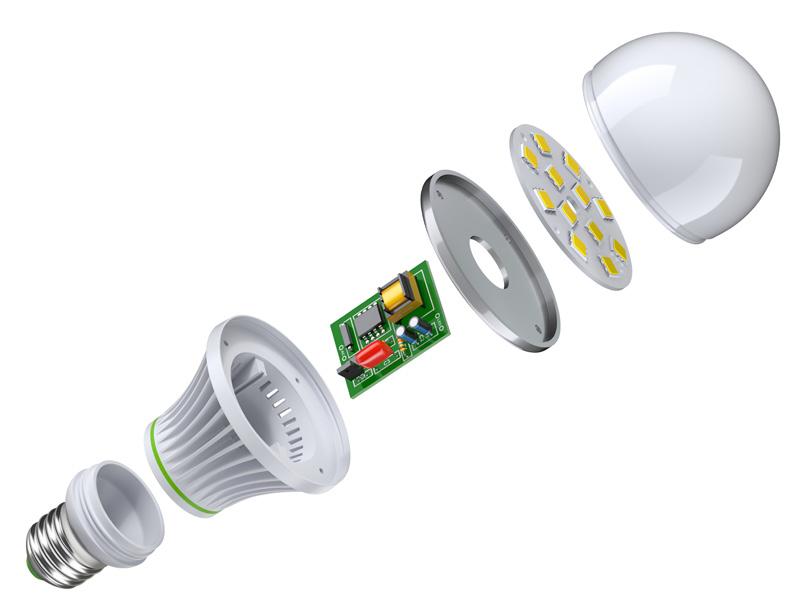
3Green Energy/Solar: Opting for a green energy source or installing solar panels to power parking structures and lots can go a long way towards sustainability. From lighting to gates to ticketing and powering EV charging stations, parking facilities can use a significant amount of energy. Drawing that energy from sustainable sources reduces the environmental impact.
4EV Charging Stations: By making it easier for EV owners to charge, including EV charging stations in parking garages encourages their purchase and use.
2Green Roofs/Landscaping: Green roofs offer a multitude of environmental advantages. Their vegetation and drainage components help to soak up excess stormwater, and they can reduce energy costs by helping to moderate the temperature in a structure. When a facility does not have a top floor conducive to a green roof, adding greenspace or other landscaping can have the same positive impacts.
5 Offer Multi-Modal Cooperation/Opportunities: Installing parking for bikes and scooters and going as far as to partner with companies that offer ride sharing for those modes can encourage users to commute using alternative transportation methods. With safe places to park and lock their bikes/scooters, and stations where they can charge electric versions, many commuters may consider this option and leave their cars at home.


Members save more than
Register for the series for
through December 31.
offered at $40
Get the parking, mobility, and transportation specific training you need. Live and on-demand training from the experts who know it best.


Gain access to national speakers and industry experts in one hour sessions that offer CAPP points and put you and your team on the CAPP Track

Understanding Curb Management: Tackling Demand at the Curb
It,
the
They
Planning for
Operation
the
Evolving Parking and

the Path to
Sense of
Programs:
Mobility in Nashville





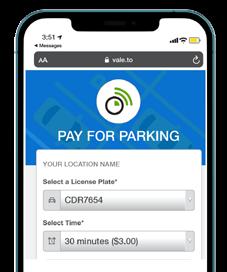
AS A LIFELONG NEW JERSEY RESIDENT, I know what everyone else thinks about my home state. I’ve heard all the jokes: “Oh, you’re from New Jersey…what exit are you from?!?!” I will concede that this perspective is somewhat valid, if your only experience with New Jersey is driving through it on the New Jersey Turnpike. The stretch of I-95 from New York City to Philadelphia is full of memorable sights (and smells) including warehouses, airports, seaports, landfills, recycling facilities, power plants, and incinerators. And that’s just Newark!
Once you travel further south, the landscape changes from factories to farms highlighting an obvious conclusion. Infrastructure and institutional facilities are disproportionately located in urban areas, impacting the health and welfare of their inhabitants. In 2020, New Jersey became the latest state to attempt to legislate a remedy through the New Jersey Environmental Justice Law. The new legislation requires the New Jersey Department of Environmental Protection to evaluate the environmental and public health impacts of certain facilities on “overburdened communities” when reviewing certain permit application.
While the goals and objectives of the Environmental Justice Law seek to attain some balance to the siting of infrastructure that has contributed adverse impacts to communities over decades, the actual solution is not so simple. The New Jersey Department of Environmental Protection recently sought to implement the environmental justice legislation through administrative rulemaking. The rules are an attempt to provide the land use tools necessary to regulate the location of proposed facilities which contribute to adverse environmental impacts. As the rule-making process advances, a few key questions need to be answered:
● What are the adverse impacts that need to be mitigated?
● What are the developments or land uses that contribute to the adverse environmental impacts?
● What processes or procedures can be implemented to control the expansion of new development in overburdened communities?
Under the current version of New Jersey’s environmental justice law there are 348 municipalities that qualify as an “overburdened community.” These are towns and cities that are deemed to meet the following criteria:

● At least 35% of the households qualify as low-income households (at or below twice the poverty threshold as determined by the United States Census Bureau);
● At least 40% of the residents identify as minority or as members of a State recognized tribal community; or
● At least 40% of the households have limited English proficiency (without an adult that speaks English “very well” according to the United States Census Bureau).
The law requires the Department of Environmental Protection to evaluate the environmental and public health impacts of the following facilities on overburdened communities when reviewing specific types of permit applications:
● Major sources of air pollution.
● Resource recovery facilities or incinerators; sludge processing facilities.
● Sewage treatments plants with a capacity of more than 50 million gallons per day.
● Transfer stations or solid waste facilities.
Recycling facilities that receive at lease 100 tons of recyclable material per day.
Scrap metal facilities.
Landfills.
● Medical waste incinerators, except those attendant to hospitals and universities.
While landfills and sewage treatment plants are easy to readily identify and regulate, ambiguity exists as to what uses constitute “major sources of air pollution.” The air pollution from vehicle exhaust is often cited as a major contribution to air pollution, and the resulting adverse health impacts that are statistically higher in overburdened communities. Specific stressors identified with air pollution include:

● Ground level ozone.
● Particulate matter.
● Car traffic.
● Impervious surfaces.
● Lack of recreational open space or tree canopy. Is this a description of infrastructure in our mobility industry? Possibly. These specific air
around parking and transportation facilities.
I’ll follow the administrative rule-making process in New Jersey to understand the outcome. Our members are encouraged to keep an eye on similar environmental justice legislation enacted in other jurisdictions. Even if environmental justice is not regulated by statute, the goals and objectives should be considered in the decisions to site and build new parking and transportation facilities. Moreover, as existing infrastructure is upgraded and improved increasing investment should be made in green design and renewable energy sources. ◆
MICHAEL J. ASH, ESQ., CRE , is a partner with Carlin, Ward, Ash, & Heart. He


Electric Vehicle (EV) charging is a unique opportunity to attract clients to your facility while developing a new revenue stream.
SKIDATA is delivering EV charging solutions to parking sites across the U.S. We have the knowledge to help you select the proper equipment to suit your needs and the expertise to help you make sure your electrical infrastructure is ready to accommodate it.
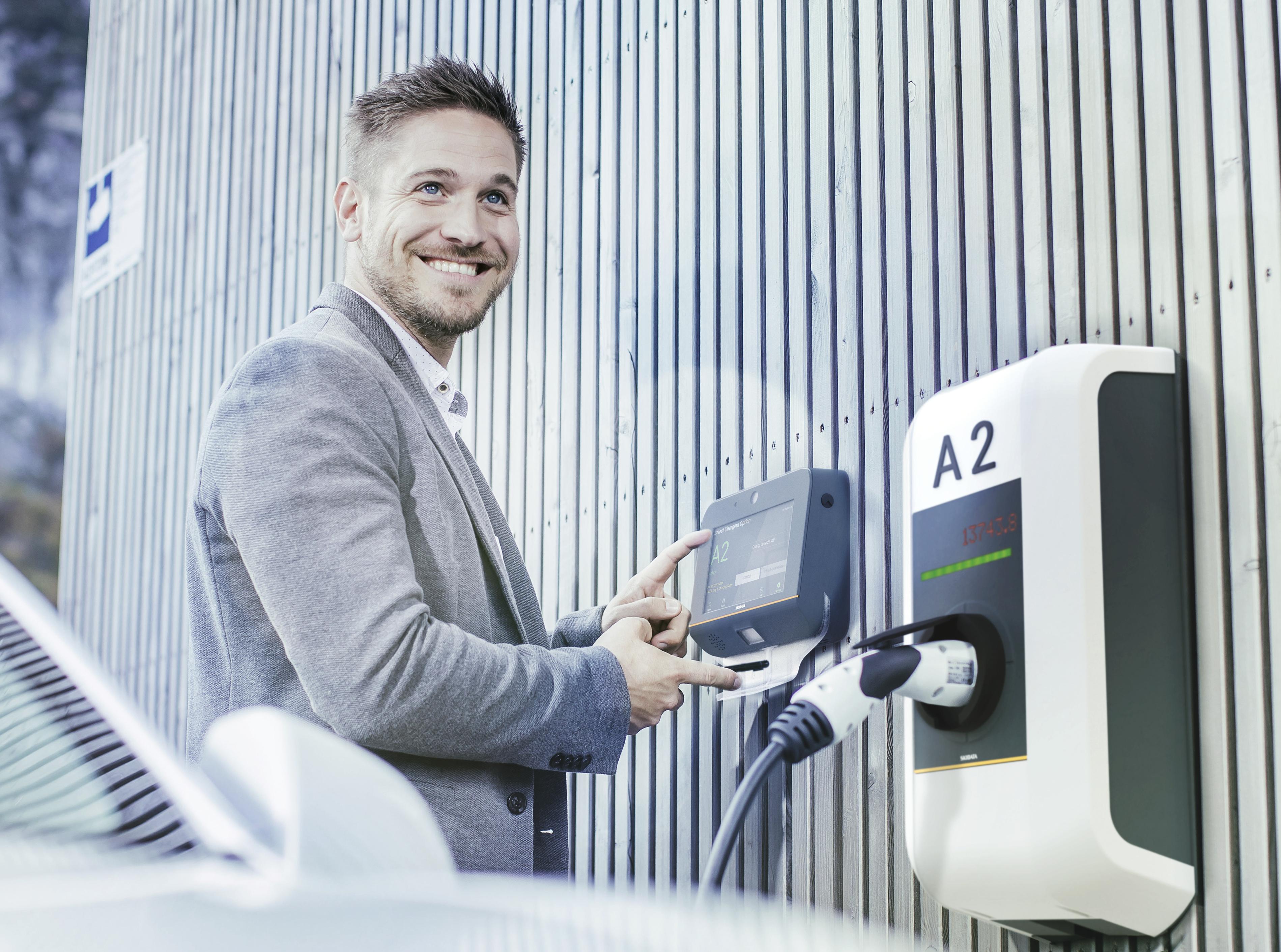
IPASS THROUGH A LOT OF AIRPORTS… and I do mean A LOT of airports. As an avid people watcher and eavesdropper extraordinaire, I’m always silently poking my nose into the business of fellow travelers. Sometimes what I overhear or see is uplifting; other times it challenges every fiber of my being to remain silent or uninvolved.
Recently, I arrived for an early morning flight out of a busy Midwestern airport. Morning flights are usually a safe bet – very few short-tempered people and plenty of the day left to rearrange disrupted travel plans. As I started my walk down the long corridor toward the gates, I heard someone running up from behind. I turned in time to see an airport police officer as he trotted passed me. Based on previous observations and experience, this scenario had all the makings of becoming an interesting morning at the airport. Having arrived way too early for my flight, I knew there was ample time to satisfy my looky-loo curiosity. I picked up my pace to follow the officer as several possible scenarios ran through my mind: was there a troublemaker at one of gates? Maybe an unruly passenger arriving on an incoming flight? It might not be my business, but inquiring minds (and busybodies) want to know.
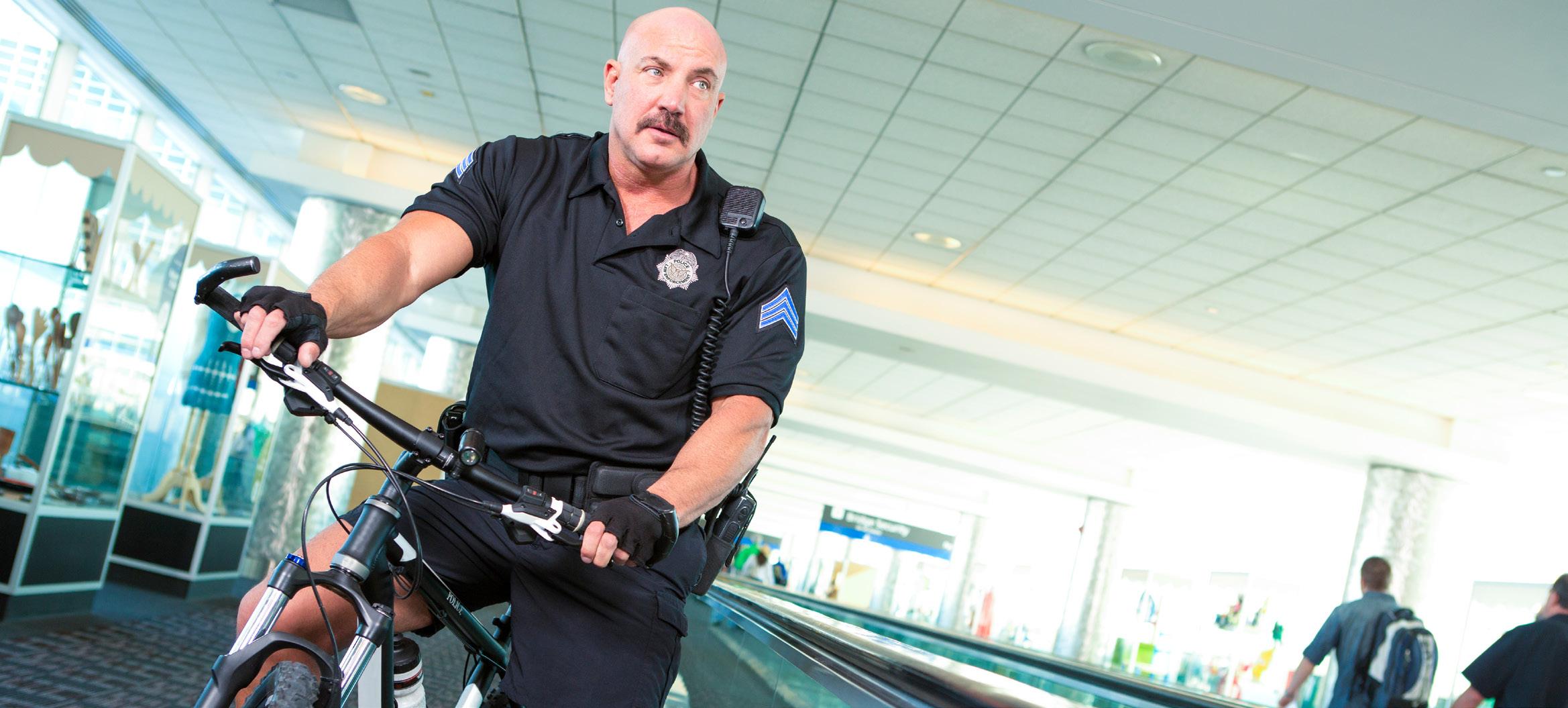
I rounded the corner and saw the officer quickly gaining on a young woman who was pushing two small children in two separate strollers. Perhaps she had been involved in an incident at the security checkpoint? Whatever had transpired, I was surely about to find out. From a slight distance, I observed as the officer began talking quietly with the woman. After a few seconds, her face relaxed into a gentle smile. She visibly exhaled as she angled the handles of one stroller into the officer’s hands. Turns out the officer had noticed the woman trying to wrangle two toddlers and all the travel accessories that go along with them. At this moment, his sole intent was to be of help to a frazzled Momma.
As I stood there, witnessing this officer’s act of empathy and kindness, it became obvious that I’d made a completely incorrect assumption about what was happening in front of me. To be sure, unruly behavior can (and does) happen in public places like
“Begin challenging your own assumptions. Your assumptions are your windows on the world. Scrub them off every once in a while, or the light won’t come in.”
—Alan Alda
airports. In our industry, we routinely experience others making bad assumptions about our professional role or the intent of our duties. We hear accusations like, “You’re not trying to help anyone—this is all about the money!” or “You enjoy making people angry, don’t you?” Certainly, we recognize assumptions of ill intent when hurled in our direction. If we accept this as true, are we also willing to recognize when we may be making similar incorrect assumptions of others?
Throughout our lives, we make assumptions—not all of them good or fair. We see or hear something familiar to us from previous experience and we assume we know what’s happening. We may even go so far as to stop listening to someone because we already “know” where this is going. When we make assumptions, we’re telling ourselves that something is true without having any evidence that it is. It becomes all too easy to conduct our lives never questioning that we are assuming things to be facts.
There’s a saying that I believe applies: “Assumptions are the termites of relationships.” Assumptions are insidious and can erode our ability to maintain perspective. When dealing with the public, it’s easy to become weary of hearing what we might label as manipulative stories or tired excuses. No one is well-served when we choose to stop listening and simply assume ill-intent. Instead, we create stories in our heads that are full of assumptions about the statements and behaviors of others. Typically, these “head stories” have little to do with reality and may escalate problems instead of providing any helpful resolution.
With a little self-awareness and effort, we can learn to modify our thought process to better avoid the assumption trap.
Before you make assumptions about anything, ask yourself: ● Do I have the facts or am I making an unfounded assumption? ● Am I more committed to proving I’m right or do I genuinely want to address the issue or concern?
Rather than interpret or guess what someone else is up to, you can ask them clarifying questions to help you determine their intent. Certainly, there will be times when our instincts are correct—and while we should continue to pay attention to our gut reactions, we must consciously avoid making unprofessional assumptions. ◆
CINDY CAMPBELL is IPMI’s Senior Training and Development Specialist. She is available for onsite and online training and professional development. She can be reached at campbell@parking-mobility.org



“Parking in a healthcare environment is critical to providing good customer service.”
- Gordon Knowles, Watry Design, Inc.
THE FIRST TIME I ATTENDED A SUSTAINABILITY CONFERENCE, I tried to take advantage of a Q&A event they held dedicated to expanding sustainability to other industries. When I brought up parking, I was told that they didn’t want to discuss it because in just a few years most people wouldn’t be driving cars anymore, and they didn’t want to promote the use of single occupant vehicles in any way.
That was about 12 years ago. I don’t know about you, but I’m not any closer to giving up my personal vehicle than I was then. Of course, alternative transportation and mobility options are somewhat more accessible than there were then, with development making both a priority. But personal vehicles continue to be the primary mode of transportation for most, especially following the pandemic.
Thinking back on this interaction reminds me of how far our industry has come, not only shifting our efforts to incorporate greener solutions, but establishing ourselves as leaders in the sustainability on a global scale. When LEED certification first came along it became (and continues to be) the standard for sustainable planning, design, and construction. LEED is still the roadmap for providing people with healthier and more cost, energy, and material efficient places to live, work, and play.
The parking industry followed close behind, launching Parksmart as the established sustainability certification for our industry. Many did not think parking could contribute to sustainability, let alone play such a significant role in developing
essential strategies, solutions, and even policies. These efforts have transformed not only stand-alone parking areas but contributed to the overall landscape of cities and communities.
On a similar note, for many years outside of the parking community, I was often asked what I would do with my career once people were no longer dependent upon cars and parking became obsolete. I heard it all the time. Of course, I was never too worried because I knew that at least in the U.S., it was unlikely that people would completely give up their vehicles any time soon. Further, our industry was pivoting and transforming in such a way to meet the evolving needs of communities, while implementing the resources, thought leadership, and collaboration necessary to contribute positively to the sustainability space.
When the trailblazers in our industry developed the Parksmart certification standard, it was perfectly designed to combine the established concepts of LEED with appropriate parking and transportation elements. LEED was an excellent blueprint for the creation of this transformative platform to develop new parking and mixed-use facilities to meet parking demands, reduce

environmental impacts, and incorporate sustainable strategies and concepts that many had not considered prior. These stakeholders now had a benchmark when creating facilities that were not previously considered to contribute positively to the environment. Many organizations now implement Parksmart standards as a requirement for their new parking and mixed-use facilities.
Since the development and implementation of the Parksmart standard, our industry has not sat back on its laurels or seen that as “good enough.” Many organizations in the parking, transportation, and mobility space have established themselves as leaders in sustainability, developing and implementing strategies and solutions that not only exceed the established Parksmart standards, but will have a positive impact on the environment, and their communities for many years to come.
Of course, EVs are the most obvious example. Many cities, parking authorities, and institutions have established requirements for EV charging stations in their parking structures, lots, and curb spaces. Our industry has been vital to this development, encouraging and accelerating EV charging station requirements and standards that will help ensure that our infrastructure can support the inevitable increase in EV ownership. This forwardthinking approach will provide that as EVs continue to become more popular on our roadways, cities and communities won’t be playing catch up to support their electrical needs.
But EVs are just a drop in the bucket in terms of how far we’ve come. Nearly every organization or solution provider in our industry is constantly looking at opportunities to develop more sustainable versions of their products, both for the good of the environment but also to keep up with consumer and operational demands. Many new technology leaders have also come to the marketplace, bringing innovative solutions that support sustainability goals and objectives.
Parking, transportation, and mobility are now very well intertwined, as they should be. The customer journey no longer consists entirely of driving straight to one’s destination, parking, and a short walk. It now often includes a combination of driving, public transit, and mobility options like bikes or scooters. The parking industry has been integral to facilitating this transition, providing organizations and institutions with the tools, resources, and platforms to create the most sustainable parking and transportation experiences possible to get people where they are going with as minimal of impact as possible.
Parking technologies continue to gain traction and help to reduce the impacts of single occupant vehicles on the environment. For example, parking guidance systems and real-time mobile parking apps significantly reduce not only the amount of time spent looking for parking in lots, garages, and on streets, but they also reduce the level of carbon emissions put out during the search.
Another technology that continues to gain traction is touchless, app-free parking solutions. The recent pandemic accelerated
this expansion as people felt more comfortable getting to their destinations in their vehicles (rather than public transit), while motivating them to seek opportunities to interact with as few outside people as possible. These solutions provide potential parkers with the option to locate a parking facility, park their vehicle, pay, and depart in the quickest and most efficient process possible. Further, they can help reduce staff, or allow them to focus on more valuable tasks like customer service or safety. On a broader scale, they help reduce the need for equipment and materials and the environmental impacts associated with both.
Many people outside of our industry (and maybe even in our industry) did not think sustainability was possible in this space; that that has been proven wrong time and again. Not only has the parking industry embraced sustainability, but we now have so many examples of developing and implementing strategies, solutions, and initiatives that are transforming cities and communities for the better.
◆
MEGAN LEINART, CAPP, LEED AP BD+C , is President of Leinart Consulting. She can be reached at megan@leinartconsulting.com


WITH DEMAND FOR ELECTRIC VEHICLES CONTINUING TO SKYROCKET —EVs are predicted to make up 23% of new passenger vehicle sales by 2025—more and more drivers are beginning to choose where they park based on the availability of EV charging stations.

As these offerings become increasingly expected in lots and garages across the country, it is crucial that parking management professionals ensure their facilities are equipped with EV charging infrastructure to meet surging demand, serve the modern driver and remain competitive with peers.
What’s more, providing this sought-after driver amenity will not only enable you to attract new and more frequent customers, but also generate an additional revenue stream through charging use fees
and comply with emerging sustainability standards by reducing carbon emissions.
To take advantage of these many benefits and stay ahead of the future of electrified transportation, now is the time to start planning for and investing in EV charging infrastructure. As you contemplate how to modernize your facilities for the next-generation of drivers, here are a few crucial considerations to take into account when selecting, installing, maintaining and financing a network of EV chargers.

As EV charging stations come in several different makes and models, parking operators and managers need to first determine which type of charger best serves their drivers’ needs.

Level 2 Chargers, also known as L2s, are well-suited for lots where drivers plan to park for several hours or overnight, such as at a mall, apartment complex, or hotel. Taking an average of eight hours to fully recharge a standard EV, L2s are ideal for facilities with less transient customers, as well as ones looking to encourage drivers to stay longer. L2s are also compatible with every plug-in car sold in North America.
For locations along highways and interstates—and primarily fueling long distance EV driving—DC Fast Chargers (DCFCs) are a better option. Capable of changing an EV up to 80% in just 30 minutes, DCFCs provide a speedy charging fix when drivers can’t afford to stop for an extended period but are significantly more expensive and less durable than L2s.
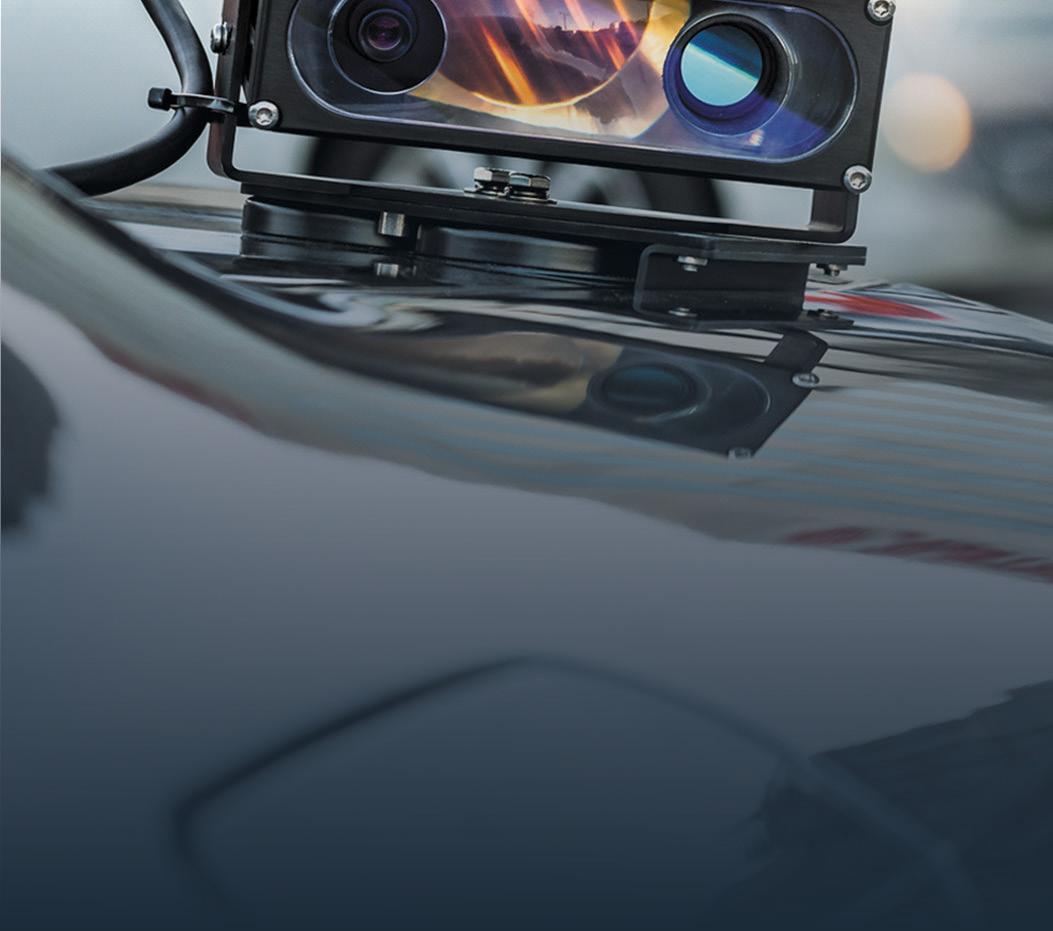

To streamline an often-intimidating deployment process, facilities are encouraged to work alongside an EV charging partner. From assessing how many chargers your location needs to determining the optimal location for placement, EV charging providers can serve as a trusted advisor during installation, as well as offer future-proofed solutions to ensure your lot or garage is prepared to meet an increase in demand in the coming years.
One such solution is EV chargers that feature local load management, which allows multiple cars to be plugged in and charged on a single shared circuit. Increasing the number of chargers a facility has available, this offering helps to prepare for future demand while being cost conscious to the current charging needs of today.
An EV charging partner can also help you strategize and respond to your location’s unique needs and limitations. For
instance, if the physical size of your lot is proving a challenge, providers might suggest installing an EV charging wall installation instead of a traditional pedestal that is drilled into that ground.


A simpler and more turnkey solution, wall-mounted chargers take up less space and have the flexibility to be moved to an alternate location later should demand or space restrictions require so.
Partnering with the right EV charging provider is crucial not only for the installation process, but also for ongoing management and maintenance of your infrastructure after deployment.


Offering EV solutions may attract new drivers to your location, but it’s essential that these stations remain working, accessible, and up to date to retain loyal customers. That’s why it’s important to partner with a full-service provider that can provide the support to manage your devices long after sale, as well as offer new upgrades to equipment when necessary. This is opposed to EV hardware manufacturers, who are not responsible for their equipment after deployment, leaving the customer, who often lacks deep EV knowledge, to manage maintenance and upgrades.
While EV charging can offer a new revenue stream, building out this infrastructure often requires steep financial investment upfront. Thankfully, there are several local, state and federal funding options available to offset these costs.
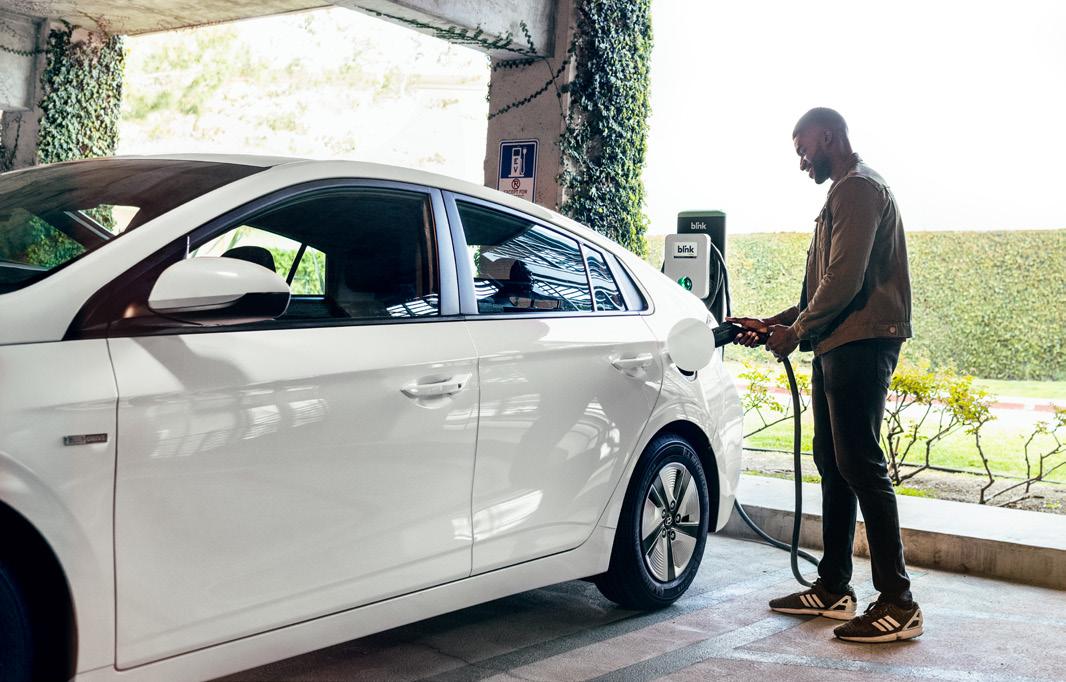
For example, the Biden administration’s recently passed infrastructure bill contained significant new funding to deploy EV charging infrastructure across the country, including $5 billion for states to distribute and a $2.5 billion grant program focused on expanding access in rural and often overlooked communities. The law also made the installation of EV charging infrastructure an eligible expense under the grant program.
As interest in and demand for electric vehicles continues to grow, parking facilities are a natural fit for EV charging stations and stand to benefit greatly from the deployment of this infrastructure. But the longer we wait, the harder it will be to keep up with drivers’ needs.

The time is now to plan, invest and deploy to ensure you are ready to meet the next generation of parking management. ◆

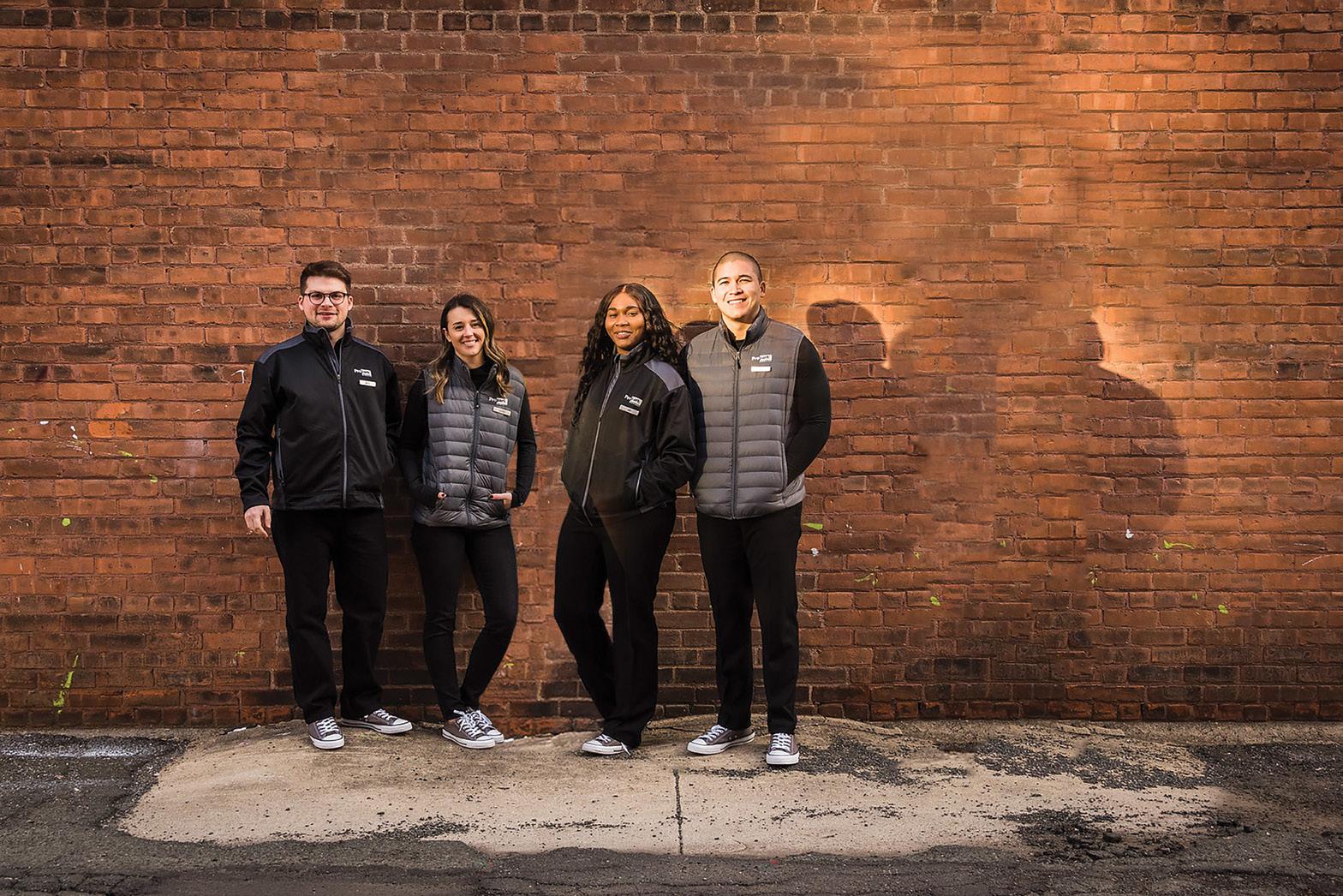

ANDY KINARD is a Field Sales Engineer for Blink Charging. He can be reached at AKindard@blinkcharging.com

 By Chuck J. Boddy, CAPP
By Chuck J. Boddy, CAPP
THE MIDDLE ATLANTIC PARKING ASSOCIATION (MAPA) is multistate organization founded in 1987 that supports parking and mobility professionals across Pennsylvania, New Jersey, Delaware, Maryland, West Virginia, and Washington, DC. Each year, MAPA presents a variety of programming, including lunch and learns, social events, and an annual conference. The goal of these events is to engage the membership in opportunities to network with other industry professionals and become more educated on hot topics in the industry.
As we close out on our 35th year of existence, MAPA has spent much of the year learning, focusing on growing membership, and keeping our current members engaged. In April, MAPA and the Parking Association of the Virginias (PAV) combined for a joint training workshop at the Hilton Hotel in historic Old Town Alexandria, VA. The workshop had great attendance, an excellent line-up of speakers, and two days of networking opportunities. This was also the perfect opportunity to bring back a MAPA
On October 4-5 we hosted our annual Fall Conference and Trade Show at Baltimore Inner Harbor Sheraton Hotel. Some conference topics included:

● Understanding the Impact & Influence of Your Communication Style
● EV Charging integration into your PARCS
We added some flair to this year’s conference by adding Garage and Gourmet—a garage rooftop networking event that provided views of beautiful downtown Baltimore coupled with a delectable dinner. Even though it needed to be moved indoors due to weather, a great night was had by all!

MAPA plans to hold our annual cruise next spring in DC on the Spirit Washington. Considering the success of the Joint Spring Workshop, we also look to pursue opportunities to partner on future events with our friends to our south in the Virginias! And above all, we always look forward to educating industry professionals and networking with our peers at events. ◆
CHUCK J. BODDY, CAPP , is Director of Parking Services for the University of Maryland, Baltimore County, and is vice president of the Middle Atlantic Parking Association. He can be reached at cboddy@ umbc.edu


The parking and mobility industry continues to play a fundamental role in driving sustainability for infrastructure, particularly in urban environments. While electric vehicle (EV) initiatives will continue to dominate conversations on sustainability and green initiatives in the years to come, what other “green” practices can we expect to see more of in the next five years in the parking and mobility space?
Rajiv Jain CEO ParkEngage

We expect parking businesses to get more conscious about measuring the true impact of their operations on the environment and define targeted strategies to continuously reduce their carbon footprint. We would see investments in precise measurement and audit tools, IoT sensors, and environmental impact analytics. We would see rapid movement towards building sustainable parking structures, with use of innovative energysaving building materials from pavement to roof, and green practices for repairs and maintenance. Operations will go fully digital, operating completely paperless, minimizing the hardware technology footprint in the garage, reducing e-waste, and dynamically optimizing traffic movement patterns to reduce energy wastages due to congestions.”
Matthew Kennedy, CAPP Executive Director New Brunswick Parking Authority
Green practices that will enjoy continued growth include the foundational factor of pricing on-street parking appropriately vis-à-vis off-street options to reduce vehicle idling, block circling, and overall traffic congestion—along with solar panel deployments, energy efficient lighting installations, the careful reduction of chlorides in snow and ice control protocols, enhanced landscaping and drainage for parking facilities, and multimodal transportation hub developments that invest in pedestrian and bicycle amenities.”
In the near future, I can see more of the population inching towards shared ownership of vehicles/means of transportation, potentially reducing individual vehicle ownership numbers. This trend is prevalent in denser regions of the country already due to the ancillary costs of owning a vehicle, including the cost of parking spaces and insurance among others.”
/ HAVE A QUESTION? Send it to editor@parking-mobility.org and watch this space for answers from the experts. The opinions and thoughts expressed by the contributors do not necessarily reflect the opinions and viewpoints of the International Parking
Mobility Institute or official policies of IPMI.
Ravali Kosaraju, PE, PTOE Director Mobility, WGI
Offers CAPP Points. Get the information you need from experts through live, instructor led courses, on demand education, and more.

Choose the learning format that's best for you and earn CAPP points too!
courses also offer valuable GBCI Continuing Education credits.
Parksmart Advisors lead clients through the certification process for sustainable parking structures Certification is led by the USGBC/GBCI alongside LEED rating systems. and IPMI is the only USGBC Education Partner providing Parksmart training. Live classes open now:

March 21, 23, 28, and 30, 2023 September 19, 21, 26 and 28, 2023
Featured courses include:
Environmental Sustainability, Wellness, Third Party Certifications & Parking

How Parking, Transportation & Mobility Operations, & Structures Affect Sustainability Outcomes
& Sustainability Innovations & Case Studies
Parksmart Sustainability Solution Series and more...



Other “green” practices we can expect to see more of in the next five years relate to elements that make it easier to choose non-single occupancy vehicles for every trip. These include a focus on creating and improving infrastructure, increasing connectivity between destinations, adding more mobility options, making it easier to find and reserve spaces, plan routes and pay for multimodal trips, and honing marketing to inspire people to make a difference by trying something new.”
Gabe Mendez, CAPP Director of Transportation Operations University of WisconsinBicycle amenities and infrastructure will continue to be another key green practice to support growth and meet sustainability goals. Providing bicycle resource centers, shower facilities, and protected shelters encourage year-round bicycling. Investing in infrastructure, such as protected bicycle lanes, will make the commute for bicyclist safer as well.”
Emily Kwatinetz Senior Associate Dixon Resources Unlimited
The parking industry is getting thrifty, and shared parking agreements are becoming increasingly common as an opportunity to leverage parking supply during otherwise underutilized times. Rather than buying or building new, it is most sustainable to use existing resources. By maximizing the use of preexisting parking, the energy output and carbon emissions associated with building new parking is avoided altogether. Shared parking is both “green” for the environment and for your budget.”

In the next five years, reducing Vehicle Minutes Traveled (VMTs) will be a tangible “green” initiative. Regardless of fuel type, every minute a car is running it is consuming energy. In response, a growing number of cities are embracing comprehensive approaches to technology platforms that look at all parking space types (on-street, garages, and lots) and provide integrated guidance to available parking in real-time thereby reducing congestion and emissions.”



Through the use of ground-based battery storage, renewable generation (such as rooftop solar PV), and integration of Vehicle-to-Grid (V2G) technologies from the increasing number of EVs, parking facilities are uniquely equipped to evolving into a source of energy. This will essentially turn a parking structure into a giant battery that can feed power back into the local (micro) grid and make it possible for parking facilities to power nearby buildings during outages, natural disasters or during periods of peak power demand when supply is strained. The result will be increased environmental resiliency and reduction of the overall cost and environmental footprint of electricity.”
Wady Burgos, CAPP Parking & Transportation Demand Management Coordinator City of WestminsterPromoting and incentivizing alternative transportation modes will continue to significantly impact organizations’ sustainability goals. Whether that’s telecommuting, carpooling, or reducing drivealone trips, we’ve learned over the last couple of years that when employees change their daily commuting choices, they make a significant impact on their communities.”
Fender

take
impact
you
how they make

A sustainable alternative is to offer a fully electric end-to-end transportation solution for your constituents. This ondemand mobility reduces the carbon footprint generated by vehicles on the road, while facilitating the movement of people. It is also a viable option as you can use advertisement funds to offset the cost.”


I think in the next five years we will see an increase in AVSRS (automated parking and retrieval systems) as they can reduce carbon footprint by 83% through:
● No running engines circulating the facility.
● Water efficiency due to the reduced size of the facility.
● Less building materials required.
● Less HVAC and lighting required.
● Average square footage per spaces is 225 SF compared to 350 SF.”



Expect to see a significant shift from personal transportation methods to shared mobility. Rising costs of living and improved mobility options will push people to choose shared modes of transportation like carsharing, bike sharing, scooters, and public transportation. On top of all the benefits of shared mobility, zero emission transportation options will see a material increase in mode share with technology advancements, autonomous vehicles, and EV infrastructure.”
The mobility industry will continue to grow in ever increasing sustainable technological offerings for multi-modal transportation. Mobility managers will become coordinators and promoters of these sustainable technologies and will deliver urban adoption through propagation of these sustainable technological programs. Parking asset owners will shift with these influences and transition parking assets into sustainable transportation centers for maximum benefit. This combination of technology, mobility management, and repositioning of physical infrastructure assets will bring about new sustainability norms.”
Many parking facilities were designed with lush landscapes that provided welcoming experiences for users. It will be challenging to modify existing landscapes, so they do not rely on irrigated lush lawns, annual flowers, and shade trees to make them appear welcoming. The transition space at a parking facilities entrance is significant in forming a customer’s view of a facility, and some facilities were not designed to stand on their own without that landscaping.”
Lissette O. Hernandez, CAPP, MPA
Director of Sustainability and Physical Plant Florida International University
Katherine Beaty Vice President of Implementation Tez Technology
Dan DeMott Chief Technology Officer Elite Parking Services of America
Director, Location Partnerships & Strategy Getaround
Andrew Stewart, CAPP Associate Director, Transportation Services UC Riverside
Click here to read more “Ask the Experts” responses from some of the foremost thought leaders in our industry.
Save time, money, and energy with comprehensive, cutting-edge planning and mobility consulting from Walker Consultants. We serve airports, event venues, hospitals, municipalities, real estate developments, transit agencies, and universities around the nation.
• Curb management and access fees
• Planning and design for (and regulation of) ride apps, commercial deliveries, and micro-mobility
• Parking planning and operations (including supply/demand and financial studies)
• Public/private partnerships and revenue enhancements
• Transportation demand management
• Transit planning and funding


THE PARKING INDUSTRY, like many other industries, has committed itself to environmental sustainability. Outside of parking, people may find this counterintuitive. After all, our industry revolves around cars—or so people outside the industry think. (Parking is really about economic development, mobility, and a host of other social considerations, but I digress).
Today, most parking owners, designers, and planners focus on finding ways to design, construct, and operate parking in an environmentally friendly way.

“Our biggest challenge in this new century is to take an idea that seems abstract— sustainable development— and turn it into a reality for all the world’s people.”
—Kofi Annan
Any discussion of green parking must start with an understanding of what sustainability means. The Brundtland Commission defined it as “meeting the needs of the present without compromising the ability of future generations to meet their own needs.” When it comes to parking, and in particular structured parking, that means finding ways to build and operate facilities in ways that won’t negatively impact living conditions now and over the course of their 50-to-70-year lifespans.
As with any sustainably designed building, parking facilities must achieve the triple bottom line of environmental sensibility, social responsibility, and economic viability. Some people simplify that to “people, planet, and profit” - all reasonable goals. The intersection of these is sustainability.
So, what are the factors that drive the triple bottom line for parking facilities?
In today’s world, sustainable parking is less expensive to operate and maintain. For instance, LED lighting uses much less energy and requires less re-lamping than older technology lighting, which makes it inherently less expensive to operate and maintain. Also, power generated on-site by solar or wind can cut the power bill.
Sustainable practices also increase the value of your parking property and generally increases occupancy (and thus rent and general parking revenues). Features such as electric vehicle charging, preferred parking for low-emission vehicles, or access to transit or micromobility can attract customers.
Indoor environments can have pollutant levels greater than 100 times outdoor levels, which may lead to health issues with occupants or, in the worst case, sick building syndrome. While parking structures are typically not considered indoor environments, there are measures that should be taken to ensure that they are not contributing to health-related problems. Maintaining proper openness for natural ventilation and selecting waterproofing systems and coatings with low VOCs are just two examples.
Green buildings have 33% lower CO2 emissions and 26% lower energy use. By developing parking sustainably, you can preserve resources and reduce urban sprawl.
People care about sustainability. They see the impact that climate change is already having, and they want to work with businesses and organizations that are working to mitigate the effects of climate change. Pursuing sustainable practices will improve the
public’s perception of your project and your organization.
The importance of sustainability in parking can’t be overstated. Single occupancy vehicles aren’t going anywhere soon. There are 287 million registered vehicles in the United States, with more than five million projected to be added by 2025. 85% of commuters drive themselves to work, and of those, 95% park for free. Single occupancy vehicles emit much of the CO2 – about 4.6 metric tons per car every year. Mitigating carbon emissions from cars with good parking facility design, construction, and operating practices is a key part of the solution.
Despite the benefits outlined above, there are some potential barriers to sustainable design, including:
● Design cost and time—complex and innovative design approaches may take more time to complete.
● Documentation cost and time to establish that the project is green—if you are trying to earn certification for your project, the process can be time consuming and cumbersome.
● Construction cost premiums—most contemporary design techniques and materials already have a lot of sustainable elements baked in, so basic sustainably is not expensive. However, if you want to pursue LEED Gold or Platinum certification for your project with parking, the price can go up. LEED Gold certification generally increases the cost of a structure by 3% and LEED Platinum by 10%.
While parking garages could be LEED certified in the past, stand-alone parking garages can no longer earn certification on their own. Garages can, however, contribute to a larger project’s LEED certification. Parking has its own sustainable design standard, Parksmart. Developed and launched by innovators in the parking industry, and acquired by the USGBC/GBCI alongside LEED rating systems, Parksmart certifies high-performing, sustainability designed and operated parking facilities.
Parksmart certification bears a lot of similarities to LEED, including consideration of:
● reducing parking footprint
● access to mass transit
● green vehicles
● bicycle facilities
● recycling programs
● commissioning of systems
● construction waste
● use of recycled materials
● stormwater management
● water usage
● renewable energy
● innovative strategies
Somewhat different from LEED, though, Parksmart also focuses heavily on operations.
The Foundry project transformed a series of brownfield sites in downtown Loveland, CO into a live-work-play community hub. It is the most recent step of the City’s long-term vision for urban revitalization, place-making, and a vibrant, walkable downtown. Consolidating public parking into a multi-level structure removes the need for surface parking and creates room for a public square and green space. Constructed with regionally sourced material and local labor, the garage also incorporates a system to treat contaminated groundwater and features the public art installation “My Favorite Things” painted on the exterior of the garage by internationally recognized muralist DAAS. The project won the Governor’s Award for Downtown Excellence from Downtown Colorado Inc.
 Photo Courtesy of WGI, Inc.
Photo Courtesy of WGI, Inc.
There are several basic elements to parking design that can help your garage be greener and earn Parksmart certification.

The process begins with selecting a site. You don’t want to replace a green field with a parking garage. That means avoiding building on parks, farmland, wetlands, or areas with endangered flora and fauna.
Management plays a huge role in promoting sustainability, and it’s really the area where you can make the greatest day to day difference. The most important management strategy for promoting sustainability is to not offer free parking. Make people understand that there is a cost associated with parking.
Build only what you need. Historically, zoning ordinances have required too much parking, and much of the time no one is parked in many of those required spaces. Providing shared parking is often an appropriate strategy. Take advantage of the mix of uses that the parking serves. If your garage is serves office space during the day, perhaps those parking spaces can be available to nearby hotels, theatres, sports venues, or other uses that need parking during the evening.

Parking facilities can promote TDM. Incentivize other modes of transportation like bikes, scooters, or walking. Offer incentives for carpooling and van pooling. Accommodate ride sharing services. Include facilities for public transit, such as bus stops. Subsidize transit passes. Include bike lockers and shower facilities to promote bicycle commuting. Combined these strategies can be extremely powerful.
Recycling programs are a great way to promote sustainability, and they are easy to implement. Also, use sustainably produced and locally sourced products in your operations. This helps minimize the embodied carbon in the day-to-day processes.
Proactive maintenance is good management, keeping operations moving smoothly. It’s also good environmental practice because keeps the facility serviceable for more years and mitigates the
extent and frequency of major repairs. Having a regular schedule for pressure washing surfaces and drains is essential. Also, have a formal program for repairing concrete cracks and spalls, expansion joints and joint sealants, and other waterproofing systems. A budget for annual engineering inspections will help your maintenance program be effective.
The quicker and more easily drivers can get from the street to a parking space, the less fuel they burn and the fewer emissions they create. Intuitive traffic circulation and simple and effective wayfinding are a must.
Technology can also help with this. Parking guidance technology directs drivers straight to areas of garages with available parking, or even to open individual spots. This is a great user amenity that also increases occupancy while promoting sustainability.



Have a plan in place to keep traffic always flowing smoothly, and particularly during peak traffic and event traffic. Traffic flow plans are particularly important for garages that serve sports venues, theaters, and other special events. The intent is to get traffic out of the facility and moving toward home with minimal idling and inching along.
Very short-term rentals, like Zipcar, allow people to rent cars for a few hours at a time. These programs help reduce the number of cars that are parking on city
streets unused. Garages are the perfect place to offer this programming and store vehicles when they aren’t being utilized. Car sharing is an ideal pairing with TDM strategies that incentivize people not to drive their own vehicles because shared vehicles are conveniently available if a car is needed.
As you select equipment and technologies to operate your facility, make sure that they are energy efficient and confirm and document performance after installation so you can verify that they are working as they should.
Choosing the right construction materials can promote sustainability. Use materials with recycled content. Most steel, for example, has 70% recycled content or more. Also, pozzolans (waste materials like fly ash and slag that can be added to concrete to enhance its performance) can be a great sustainable choice. And when possible, use locally sourced materials.
Every construction project creates waste. Have a plan in place for responsibly disposing of that waste, diverting it from landfill to the extent practical.
Providing infrastructure for alternative fuel vehicles is a great way to promote sustainability. With the auto industry transitioning to all-electric fleets over the next decade or so, owners should already be adding EV infrastructure and clearly marking EV spaces, so they are easy to find. Not only will this help you serve your EV customers, but it will also help promote the transition to cleaner EV cars by encouraging your customers to make the switch to electric vehicles. The Green Construction Code calls for 4% of parking spaces to have EV equipment and for there to be enough capacity for 8% of employees to access EV charging. It also calls for 20% of parking spaces to be EV spaces in residential development. The state of California’s codes are even more aggressive, calling for 100% of residential spaces to have EV charging capabilities.
As mentioned earlier, supporting bicycle commuting is a great way to promote sustainability. Provide appropriate space to store bicycles and tools, tire pumps, etc. to enable routine maintenance and minor repairs.
The PARCS technology and operation are powerful tools for promoting sustainability. The less queuing you have at the entries and exits, the less cars will be idling and producing emissions unnecessarily. There are several technologies that can help reduce queuing, including pay-on-foot operations and pre-booking, both of which allow drivers to pay for their parking session before they get in their cars to leave the garage. Gated parking utilizing LPR or AVI allows people to enter and exit without having to manually interact with lane equipment. Better still are facilities without gates that allow vehicles to free flow in and out.
Properly inflated tires promote fuel efficiency. Providing tire inflation in your garage is another way to promote sustainability while offering a valuable customer amenity.
Exterior openings do more than admit natural light. They also provide vital ventilation to help disperse emissions from vehicles in the garage.
By circuiting your lights strategically, the lights around the perimeter can be turned on and off based on the position of the sun utilizing timers and light sensors. Dimming of interior lights and occupancy sensors that turn lights on when moving cars and pedestrians are present are becoming more prevalent.
Consider including pervious pavement, water detention strategies, bioswales /rain gardens in your design to collect stormwater and reduce flooding. Rainwater harvesting, where permitted, captures rainwater, and uses it for irrigation of plantings. It’s best to use water efficient landscaping that doesn’t require a lot of water.
Since we are talking about water, consider using low flow fixtures in bathrooms. Also, where possible, reuse sink water and water for showers (aka gray water) as irrigation for landscaping.
There are several ways that you can promote sustainability through the design of your garage’s roof. Green roofs covered in vegetation and blue roofs with stormwater retention reduce heat island effect and shade vehicles, which decreases fuel evaporation and reduces air conditioning use
In fact, there are several potential on-site energy generation options. In addition to solar, some parking facilities generate energy with wind turbines, geothermal technology, low-impact hydroelectric, and biomass. Each garage is different and requires its own unique approach.
The heat waves and extreme weather we’ve experienced this summer demonstrate how climate change is already impacting us. Part of the response to climate change is to attempt to minimize carbon emissions and the embodied carbon. This is just as true for parking facilities as it is for other building types. Sustainable design, construction, and operating practices don’t merely help reduce parking’s carbon footprint; they also represent a commonsense approach with sound financial footing that promotes occupant well-being. ◆
ROBERT MCCONNELL, PE, SE , is Vice President, Parking Solutions with WGI, and is a GBCI Certified Parksmart Advisor. He can be reached at rob.mcconnell@wginc.com

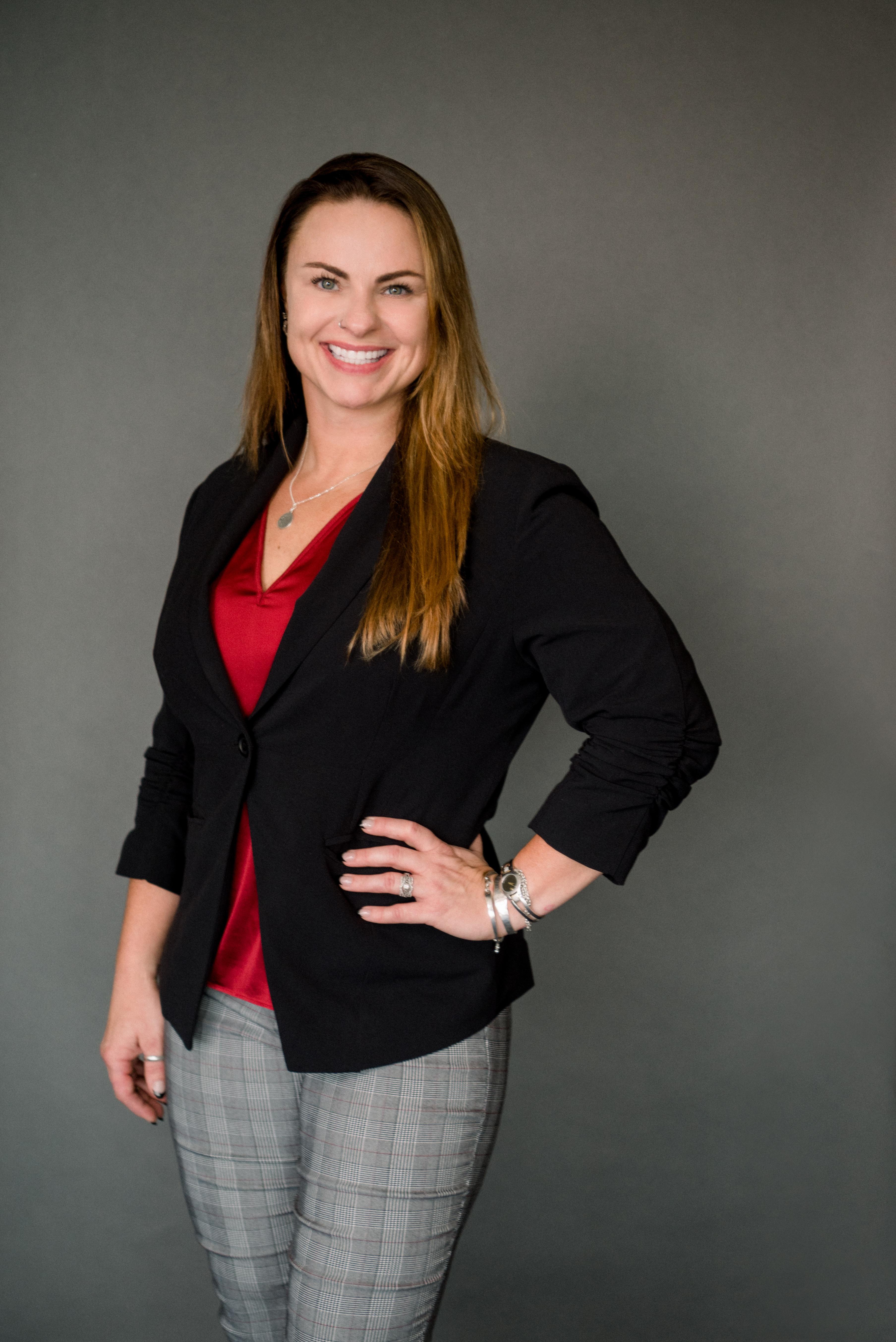



 By Bill Smith, APR
By Bill Smith, APR
THE ADVENT OF THE EV AGE is about to make parking management more complex for parking owners as the auto industry becomes electrified. President Biden has called for half of all auto sales to be electric by 2030, and the auto industry is responding with aggressive EV goals. General Motors plans to produce only EVs by 2035 and Ford and Stellantis (formerly Fiat Chrysler) plan to be 40% electric by 2030. Volvo is being even more ambitious, promising to go all-electric by 2030.
This trend promises to significantly impact parking owners of all types. While the bulk of EV charging will take place at home, many drivers will need to juice up when they travel or after they commute to work or play. Parking facilities provide the most obvious source of recharging when drivers need to recharge on the road. Local and national authorities seem to think so too, with some beginning to implement codes mandating EV charging and putting the infrastructure cost on parking owners.
“There’s a lot of pressure coming from outside to add EV charging,” said Rob McConnell, Vice President at WGI Inc. “Some states and municipalities, California for instance, are already setting requirements for offering EV charging in new development. Other states will follow soon, so it may be time to start thinking about how to add EV charging, what types of equipment to offer, and a timeframe for adding the equipment.”
With the auto industry’s evolution to EV being completed over the next decade, many parking owners will install EV charging stations in the coming years. In fact, because building codes are beginning to mandate that EV charging be included in certain developments (particularly residential), the question isn’t whether to install EV technology, but when, which types, and how many units.
Let’s start with when. If owners are already seeing electric vehicles in their parking facilities, the answer may be “now” or at least “soon.” Many have already begun installing charging stations. But just because the auto industry has begun the conversion to all-electric fleets, that doesn’t mean you need to add EV charging stations to all your parking spaces now. It will be nearly a decade before even the most ambitious automakers plan to be all electric, and a few years later for the others. Plus, drivers won’t all immediately switch over at once; they will continue to drive their gas-powered cars and trucks for a while. Today, the average vehicle on the road is 12 years old—and that trend will continue even after the auto industry completes the conversion to all-electric production. Realistically, it will be another 20 years or so before most drivers be driving electric vehicles. So, owners can stagger their installation of EG charging over several years.
“EV equipment is expensive, and parking owners don’t want to invest valuable capital before it’s necessary,” said David Rich, vice president of the parking consulting firm Rich & Associates. “Plus, as with any new technology, it’s reasonable to assume that the cost will drop significantly as new manufacturers enter the market. Why spend $12,000 per space today when the same technology may cost $1,000 or less in a few years?”
According to Rich, owners should work closely with their planning teams to estimate what demand is going to be over the next 15 to 20 years and how that demand will grow from year to year. Then they can make an informed decision about how many EV units to install each year.
After working out the related issues of when and how many EV units to install, the next essential issue is what type. There are three basic types of charging equipment. Level 1 is more of an entry level charger, and it uses a normal 120-volt connection, like a standard household outlet. It’s the slowest charging option available and tends to be more suited to overnight charging, so these may be the best choice for residential developments. Level one chargers typically cost between $300 and $600 each.
“While this may be a good choice for residential complexes, it may not be the best choice for parking facility owners and stand-alone charging stations,” said John Abraam, principal at Strategic Energy Solutions, Inc. “They may be underpowered when it comes to their parkers’ needs because it takes so long to fully charge a vehicle.”
Level 2, the most common charging station, may be a better choice for most owners. Level 2 is 240-volt technology that can fully charge a vehicle in about three hours. Level 2 stations cost between $2,000 and $13,000 and average out to around $6,000 each. A level 2 station can typically fully charge a vehicle in three to eight hours.
Level 3 charging stations are by far the fastest and most expensive. They operate at 480-volts and can provide an 80% charge in about 30 minutes. The average cost of a fully installed level 3 EV charging station is around $50,000 to $80,000 and they may require a utility company to install new service. For owners considering a level 3 station, it’s a classic cost/benefit question. Owners
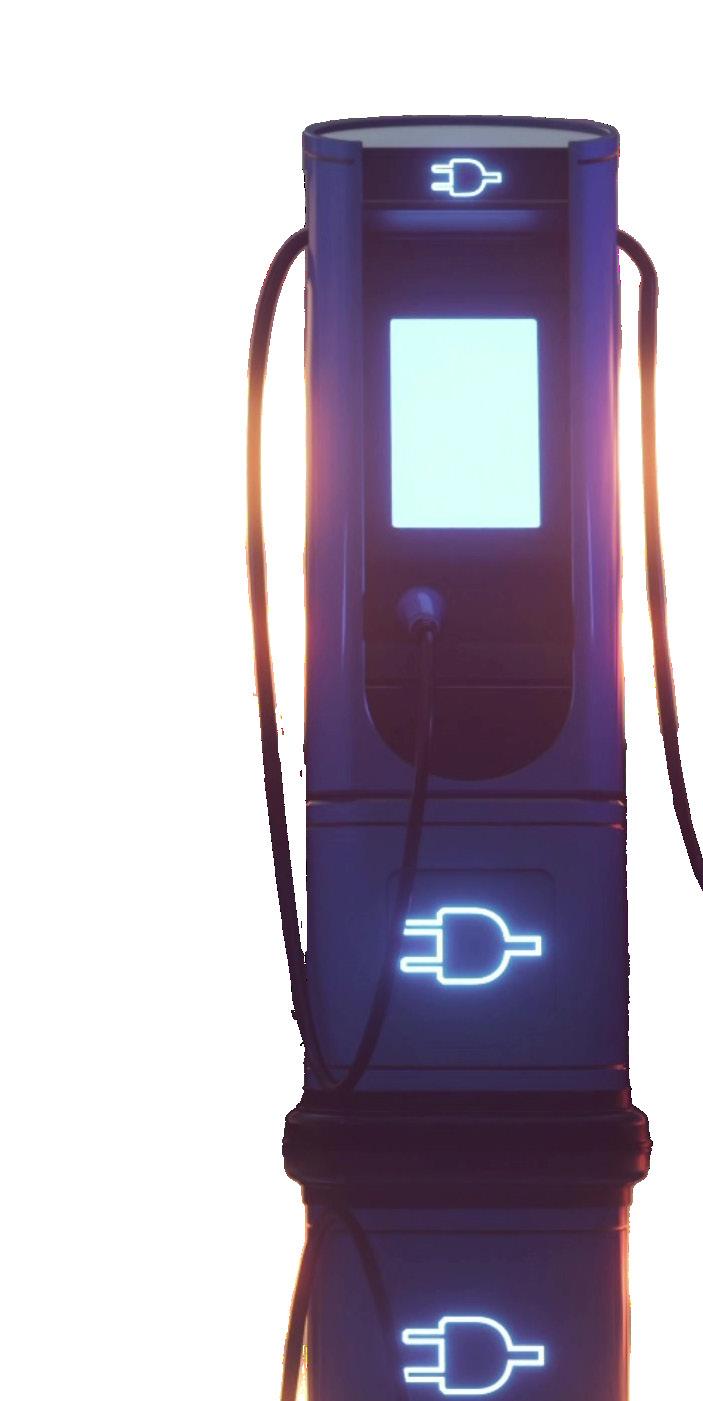
The EV units are the most visible element of the charging stations, but the installation doesn’t end there. Infrastructure is required to bring electricity to the units. EV charging requires power supplied by a local utility; wiring to convey that power; conduit to house the wires; and of course, the charging stations.
tend to want to provide the best parking experience possible, but many will find the cost prohibitive.
It’s important to remember that the decision about which level charging to utilize doesn’t revolve around the brands of vehicles that are being charged. Each OEM manufacturer uses the universal level 2 J1772 connection or one of two DC CCS or Chademo connectors (Tesla, perhaps the best-known electric vehicle manufacturer, has its own proprietary connector, but an adapter is included with each Tesla to allow vehicles to charge at all L2 stations). Decisions should be based on cost and how the parking owner wants the charging station to impact the use of parking spaces. If more frequent turnover is desired, levels 2 or 3 may be suitable; if long-term or overnight charging will be the norm, level 1 may suffice.
The EV units are the most visible element of the charging stations, but the installation doesn’t end there. Infrastructure is required to bring electricity to the units. EV charging requires power supplied by a local utility; wiring to convey that power; conduit to house the wires; and of course, the charging stations. Developers and owners should consult their parking consultants or EV specialists to make sure they have a handle on this infrastructure and how it will impact their EV charging plans.
Another thing to consider is whether to invest in networked EV charging stations. These Wi-Fi-connected stations limit access to specific users (like residents of an apartment building), charge users for electricity consumption, monitor the station’s performance, and provide usage reports. Networked stations cost more than nonnetworked ones, but they may be worth it because they are easier to manage. Some EV providers offer user-friendly turnkey solutions and will bundle everything together, making the technology more manageable.
“Some providers will help put in new conduits, power lines, and EV charging systems and set everything up,” said Chris McKenty, VP of Sales and Marketing at SKIDATA. “The EV technology can even be integrated into the facilities PARCS system to allow the parker to pay for the EV charging as part of the parking transaction.”
Weight is another consideration. EV batteries are heavy and electric vehicles can weigh considerably more than traditional vehicles that run on gasoline. For instance, the EV version of the GMC Hummer has several batteries for extended range and expanded power and weighs more than 9,000 pounds. This is about three times the weight of a Toyota Corolla. This may be a consideration for multi-story parking garages.
“You’d have to look at your entire parking structure with a building engineer,” said McKenty. “Can the garage handle it if you have all these heavy electric vehicles parked on the top floor? You could be adding an extra 60,000 pounds onto the weight of that floor deck.”
It won’t be long before electric vehicles are the rule, rather than the exception. When that time arrives—and it will be sooner than most people realize—developers and owners will need to have adequate EV charging resources to meet the needs of their parkers. It’s time to start ramping up to meet that need. ◆

BILL SMITH, APR is a business writer specializing in the parking industry. He can be reached at bsmith@smith-phillips.com

 By Steven Fernstrom
By Steven Fernstrom
IN EARLY 2020, the Bethlehem Parking Authority (BPA) began to conceptualize incorporating a sustainability program as a built-in addition to our organization. Our goal was to build a robust program that would set an example for continuous sustainability improvement. After two short years, we could never have imagined what we would achieve. Success started with a clear understanding of what it takes to build a successful program. The building blocks of our program have been setting attainable and realistic goals; having the buy in and support of our Board of Directors and Mayor; and having a hardworking, dedicated team that is passionate about sustainability.
Any organization, large or small, has the potential to negatively impact the environment. A parking organization is no different:

● We literally invite emission emitting vehicles to our facilities daily.
● We own and operate facilities that consume large amounts of energy 24 hours a day, seven days a week.
● We have large vehicle fleets that will circle city blocks for hours at a time.
● We design and build large structures.
● We use potentially harmful cleaning products.
● We often have a large staff that consumes water and electricity daily.
In addition, most parking organizations are within dense, urban environments. Bethlehem is located in a PA DEP Environmental Justice Area, where historically minority and low-income residents have been forced to bear a disproportionate share of adverse environmental impacts. The opportunities to control our impacts were endless. We knew we had plenty of work to do, and that that work would keep us engaged for years.
As the former Sustainability Manager at Sands Bethlehem, a one million square foot integrated casino resort, I am familiar with how rewarding it is to start and maintain a successful sustainability program. At Sands, I was fortunate to learn from industry leaders while being part of the most recognized and successful sustainability programs for integrated casino resorts. The obvious reward of a successful sustainability program is reducing an organization’s environmental impact; but seeing likeminded sustainability-driven members of the team focused on your organization’s sustainability initiatives, and having pride in their impact, is equally rewarding.
The sustainability program at BPA is arguably one of the most robust of its kind. It includes sustainability in all aspects of parking authority operations, and encourages active engagement from BPA’s leadership, team members, the community at large, and customers.


But what did it take to plan and launch this program? And what were the key factors that led, and continue to lead, to long-term success? Let’s discuss the path that we took, and the lessons learned.
Having allies to join forces with will make your journey easier. Any time a municipal parking organization can align their program with their city’s goals, it adds to the power of the effort. Don’t be alone on an island if you don’t need to be! Fortunately, in Bethlehem our current
Mayor has deep sustainability commitments and goals. In 2021, Bethlehem Mayor J. William Reynolds launched the city’s Climate Action Plan , marking the beginning of a sustainability-focused journey for the city. The Climate Action Plan established a new vision for Bethlehem as an equitable, prosperous, resilient, healthy, and inclusive city that takes actions to mitigate climate change while increasing our preparedness for climate change impacts. Mayor Reynolds said, “City government and our environmental coalition of community voices must design, create, and implement a vision in which every resident is able to be part of the journey to a more sustainable and equitable Bethlehem.”
Understanding the framework on how to successfully build a sustainability program, our team set off on the journey to create and build our own. First, we set up a small committee of sustainability-minded team members to champion starting the program. We knew we couldn’t mandate team members to be a part of effort, so we opened it up as an invitation to join. Our hopes were to attract team members that had a passion for sustainability. Once our team was set, we started to work establishing program goals.
Sustainability is a far-reaching subject, so setting and committing to attainable and realistic sustainability goals can help an organization stay focused what factors can have the furthest-reaching impacts to the environment. While it can be easy to come up with a long list of projects, it is important not to get mired down with smaller, less impactful initiatives.
As all the departments at the BPA can impact sustainability in some way, all departments were represented in creating our list of goals. With an open forum to start, the committee examined what within each of their departments could potentially negatively impact the environment. We then identified and created three program pillars that we bucket these examples into, and keep our progress organized: Transportation, Efficient Operations, and Green Garages.
The Transportation pillar involves emissions reduction through public transit partnerships, promoting alternative transportation and alternative fueled vehicles. The Efficient Operation pillar focuses on our day-to-day operations and how we can create and implement operational processes to reduce our resource consumption. This pillar focuses on how our everyday actions and standard operating procedures can affect the environment, such as energy and water consumption and
the waste we generate. Finally, the Green Garages pillar is all about designing, building, and maintaining our parking structures sustainably.

We felt it was important for the sustainability program to have its own identity, with these pillars at the center. Building an identity around the sustainability program was important to demonstrate that it was more than just a tag line or a page on our website - it’s was a commitment. The program identity, represented by its own brand logo, made it easier to tell the sustainability story and delineate it from the rest of the organization. Sustainability initiatives were included as a consistent line item on our five-year strategic goals, and we began budgeting yearly for sustainability initiatives. It is also a substantial topic of our end of year highlight presentation to our Board of Directors. “We actually have the sustainability logo on one of our EVs, it’s a conversation piece to the public,” said Dick Lynn, BPA Facilities Manager.
Once the BPA laid the foundation for the sustainability program, it was time for us to get to work on how these pillars would translate into tangible success. We started by prioritizing our goals based on the weight of the impact and how realistic it was from a time and financial commitment to make real progress. We then matched those with our program pillars and developed our yearly action plan. Each year, we prioritize the lowest hanging fruit and any potential grant funding that was applicable for our projects. In the past two years, we’ve received over $100,000 from the Commonwealth of Pennsylvania for sustainability projects. Your local government websites are a great resource to find potential grant funding.
The biggest success to date in our Transportation Pillar is the conversion of our vehicle fleet to electric vehicles. To date our fleet is made up of 40% electric vehicles, with the majority belonging to the Enforcement Fleet. We started the conversion to EV with the Enforcement Fleet because their vehicles are in operation most of the day. In late 2020, the BPA began to replace their aging Enforcement Jeep Wranglers in favor of Chevy Bolts and Nissan Leafs, all with License Plate Recognition systems. The conversion to electric vehicles, along with a prioritization on biking and walking, eliminates the consumption of approximately 2,500 gallons of gasoline yearly.
The BPA was the recipient of the Pennsylvania Department of Environmental Protection 2021 Alternative Fuel Incentive Grant, one out of only three awards given to organizations in the Lehigh Valley in Pennsylvania. This funding was vital to the success of this initiative, and BPA received overwhelming support on this and future grants from State Senator Lisa Boscola’s office. To keep our commitment to promoting alternative fuel strong, we installed more than 20 EV charging stations in our parking garages and two
surface lots, a large portion funded by the PA Drive Forward grant program from the Commonwealth of Pennsylvania. Since 2020, our EV charging stations have realized a reduction of about 40,000kg in GHG emissions.

BPA also partnered with the Lehigh and Northampton Transportation Association (LANTA) to heavily promote the use of public transportation. This initiative started with our new Polk Street Garage, which is conveniently located next to the new Southside bus stop. We will install static and dynamic signage throughout the structure providing information like promotions, bus routes, and general LANTA information. The partnership with LANTA provides options and information to encourage our parkers to use public transportation to get to their further destinations.
We’ve also had a lot of great success in our Efficient Operations Pillar. We are proud to announce that all our garages and parking lots are 100% LED, which greatly reduces our energy consumption. In 2022, the BPA partnered with Lehigh University’s Community Fellowship Program to, among other projects, develop a comprehensive lighting database for all fixtures and lamps throughout all BPA properties. The worksheet captures information including the location, model, kWh consumption, useful life hours, date of install, and the projected end of life date for the lights. The BPA can then use this information to analyze other lighting options in planning for future upgrades and leverage the buying power for a mass lighting purchase. Our parking garages and lots have incredible potential for savings thanks to the large quantities and necessity to keep the lights on. Partner that with the ever-changing landscape of lighting becoming more efficient, light harvesting potentials, and smart lighting opportunities, lighting will always be a high priority to the BPA.
BPA has also retrofitted our office water fixtures to low flow and added integrated occupancy sensors in all our office spaces to keep the lights on only when needed.
Another achievement under the Efficient Operations Pillar is the creation of standard operating procedures prioritizing Enforcement Officers using walking and bicycling beats. Our Enforcement Department has created “Green Walking Beats” that were previously performed by vehicles, focused on accessibility. These standard operating procedures not only reduce the impacts to our environment, but also promote wellness and health for our team members by instituting a robust set of standards for walking and bicycling. When it’s not conducive to walk or bike, the standard operating procedures mandate our PEOs to use one of our EVs first before using a combustion vehicle. Some days, the BPA is vehicle emissions free!
We also worked with our cleaning products supplier to baseline our inventory, using that to identify and procure like products that are green certified. We also employ scrubber machines that use 70% less water and have a robust recycling program in our team member spaces.
Arguably, the BPA’s most important and proudest sustainability moment came from our Green Garages Pillar. In March 2021, the BPA Board of Directors unanimously passed a Sustainable Design Standards Resolution. This resolution solidified the commitment to the future design and construction of all parking garages using the Parksmart certification standards. Our first project using these standards will be the 731-space Polk Street Parking Garage designed by Desman Associates, which will be opening in late 2023.
The success of our program really relies on the commitment of our team members. Our team members are the ones that are out on the front lines of our operation, performing the work and putting our goals into play. Inclusion of our team members in the sustainability program was a focus in its creation. Team members shouldn’t be kept in the dark during sustainability planning; actually, the opposite - they should be provided the tools and knowledge to help drive what their organizations do, why they do it, and how they do it. They need to be educated on why they’re being asked to perform some of the tasks around sustainability: why they are using the machines and vehicles they’re being asked to use, and why they are
utilizing some of the green products the BPA procures among many other explanations. When a team member fully understands the process between A and B, they’re become a part of that process and they tend to become more committed to their duties.
BPA team members are also our ambassadors to the public. When a customer sees them using a green product or a scrubber that uses less water, that team member can speak eloquently to the process and promote the brand, giving the public further piece of mind the organization is running responsibly. We also found that many of the best of the operational ideas come from the minds of the team members that are out in the field each day. We’ll incentivize a team member that provides us with a Green Idea, and we end up making it one of our goals!
BPA will continue to focus on our Efficient Operations Pillar by working with our vendors and partners on technology and efficiencies that can reduce our impacts. We will look for additional ways to for people to do the right thing without having to even think about it. In 2022, we started to offer scan and text-to-pay in our parking garages to reduce idle times at our gates. We’re also promoting the use of virtual tickets, app use, and reservation-based parking to reduce the use of paper tickets as well. These frictionless and efficient options are good for the business and can help reduce our impacts - it’s two-fold. “The elimination of mag stripe tickets was huge for us, not only did it increase efficiencies, but it also greatly reduced the amount of paper and waste going to landfills,” added Paul Wagner, BPA Maintenance Supervisor.
2023 will also bring an exciting new partnership with a local elementary school, where BPA team members will travel to the school to educate the students on green initiatives and hold several “green events” during the year. We’re extremely fortunate to be in a position where we can intersect the parking industry with our local schools in a positive way. This will by far be our most rewarding and impactful project as we work with the youth of Bethlehem to educate them on living sustainably! ◆
STEVEN FERNSTROM is Executive Director of the Bethlehem Parking Authority, and a member of IPMI’s Accredited Parking Organization (APO) Board. He can be reached at steve@bethpark.org

Get best-in-class education from subject matter experts through small group sessions. Member and nonmember rates apply. Each course offers CAPP points.
Industry experts lead interactive, online education for frontline staff. Free for all IPMI members.
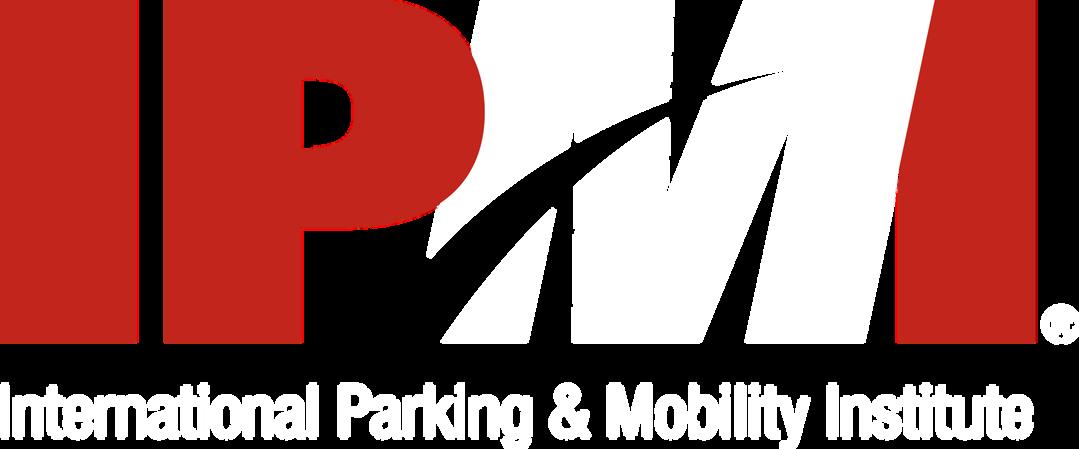
Connect and expand your network during virtual, interactive discussions on the most relevant trends and topics. Free to all industry professionals.
Members register for a single webinar for $35. Each webinar offers 1 CAPP point, and puts you on the CAPP Track!



ATLANTA’S GRANT PARK GATEWAY is the first project in the world to achieve LEED, SITES and Parksmart certifications through GBCI. The City of Atlanta addressed the need for a new parking garage near Zoo Atlanta and the Beltline, two of the city’s most iconic public spaces. With in creased calls to reduce traffic congestion and improve community safety, the ex isting 8-acre surface parking lot was unable to keep up with increasing demand.

Faced with a major renovation, Atlanta’s Parks and Recreation Department (DPR) used the opportunity to invest in a multifunctional, sustainable space, using certifications as a tool to direct their work for the greatest community benefit. Instigated by the DPR, this inspirational project transformed an asphalt parking lot into a beautiful community space that now includes a shaded terrace plaza, green roof and restaurant space, acres of greenery, and parking for more than 1,000 vehicles. The Gateway is a testament to what can be accomplished when a project team is able to pursue a holistic vision that balances mobility and accessibility with a sense of place.
In addition to promoting sustainable mobility through bicycle parking, access to a nearby bicycle sharing hub and electric vehicle charging, the garage’s biophilic design strategies and sustainable land development have created a sweeping green space for the Grant Park neighborhood that acts as a destination itself.
Atlanta’s Grant Park Gateway uses Parksmart, SITES & LEED to achieve sustainability goals.Grant Park Gateway also demonstrates how GBCI’s sustainability rating systems can complement one another. The project combined three sustainability certifications: LEED for green buildings, Parksmart for parking structures and SITES for land design and development. While balancing multiple sustainability goals on a project is challenging, rating systems with clear performance thresholds provide guidance to simplify this process and evaluate how to make the greatest impact.
“The project scope was a blend of infrastructure, site improvement and new building construction, all of which were equally important,” shared Todd Fuller at HGOR, the landscape architect. “Pursuing multiple certifications created benchmarks for performance appropriate with each individual scope, to ensure that all aspects of the project were high-performing.”
Beth Ament at Epsten Group, the sustainability consultant, described an ordinance put forth by the City of Atlanta in 2017 mandating that all new construction projects owned by the city and of a certain size and cost must achieve LEED Silver certification. Epsten Group reached out to DPR early in the process to share information on Parksmart, since most of the project scope encompasses a parking facility, as opposed to a building.
“Through the work being performed at neighboring Zoo Atlanta, we understood that there was a larger project boundary at play that made SITES certification for sustainable landscape development a reality,” says Ament. “Our teamwork with Breedlove Land Planning and their overall vision for the larger boundary of work is what made SITES possible. We executed due diligence to educate the entire project team about the crosswalks across the different rating systems, helping them to understand that this also meant a reduction in the amount of work needed on our part.”

With the three rating systems, says Ament, there was overlap in requirements that was easy to address within the project scope. “For the LEED project, the number of points available were very slim, and we knew the project could not live up to the city’s requirement of a LEED Silver project. However, we were able to apply our SITES Gold certification to the LEED application. We were awarded all the points within LEED’s Sustainable Sites




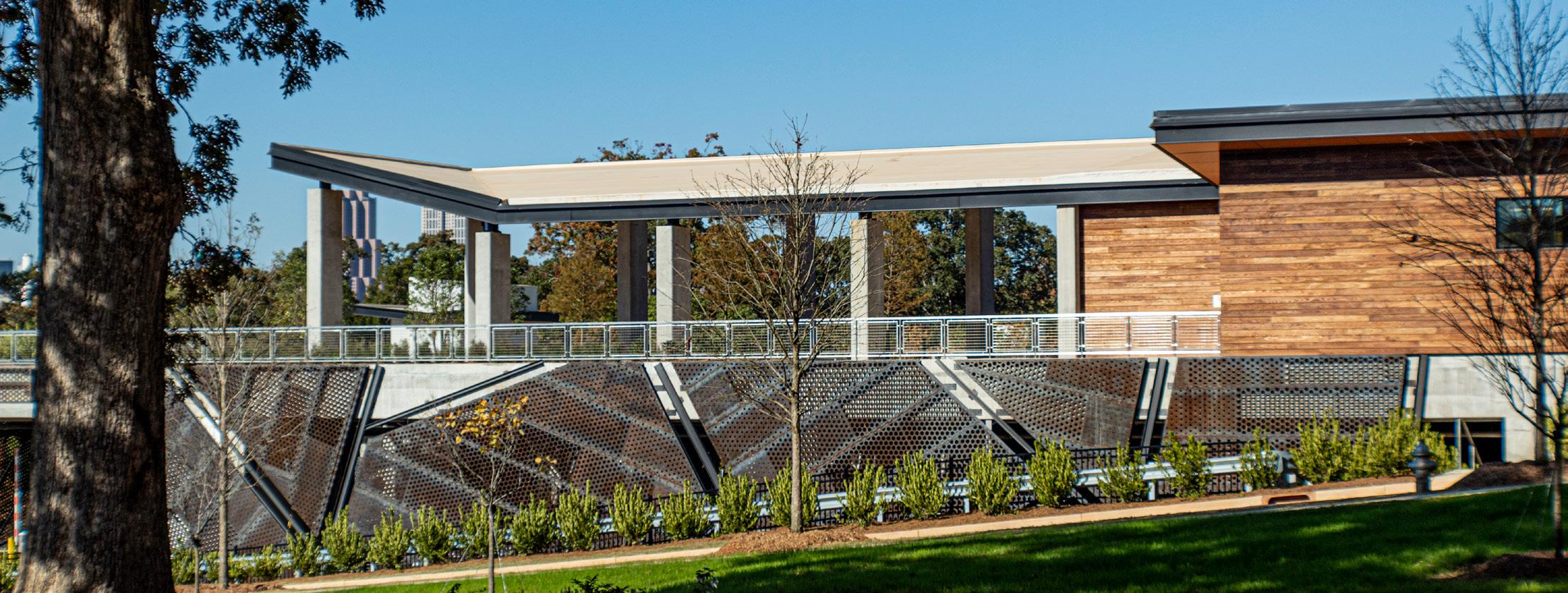

credit category, pushing the LEED project up to Silver,” explains Ament.
Grant Park found solutions that accommodated more parking in a greener way, as well as enhancing access for alternative transportation.
“The project removes an existing surface parking lot from Atlanta’s oldest park, and replaced it with usable green space, while improving safety and access for pedestrians and bicyclists coming to the park and within the park,” says Todd Fuller of HGOR, the project’s landscape architect. “Increased parking had the double positive benefit of granting a broader access to the park from residents across the city traveling by car, while relieving the impact of off-street parking that was previously occurring on neighborhood streets,” he adds.

DPR was thrilled to take part in such a transformative project with multiple sustainability features, according to Keith Hicks, director of park design for the city. “[It creates] an inviting and dynamic experience for residents to enjoy gatherings, festivals, recreational activities, outdoor dining and people-watching,” says Hicks.
The City of Atlanta has experienced “explosive growth” in the past few decades, says Ament, and making that increase true “smart growth” is a priority for the Atlanta Office of Resilience. “Equal access to resources, amenities and preservation of the natural environment are all visions set forth for the city,” Ament shares.
The combined certifications for this project reflect a resilient strategy and far exceed the City of Atlanta’s Ordinance 17-9-128, Sustainable Development Design Standards. And as the first space in the world certified to LEED, SITES and Parksmart, the project serves as an example not just for Atlanta, but for any city around the globe.
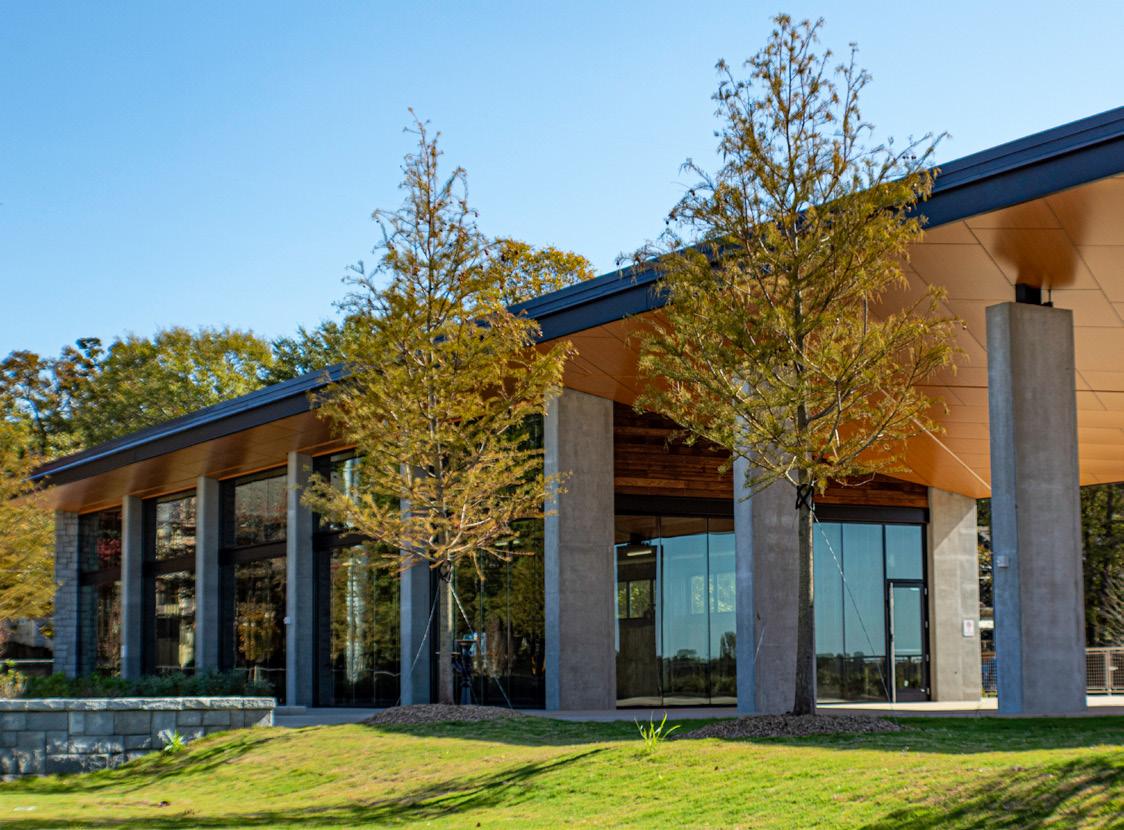
The many teams involved in Grant Park Gateway’s development proved that through integrative, thoughtful, and creative design, a parking lot can become an extraordinary space.
◆
SUMNER BYRNE, LEED GA , is Senior Manager of Product Marketing for Green Business Certification Inc. (GBCI) and the U.S. Green Building Council (USGBC). She can be reached at sbyrne@usgbc.org

AMANO MCGANN , a parking technology company, announced that Amano ONE, the most simplified, powerful, and reliable parking access and revenue control system, is now available at Chicago’s Soldier Field. With 20 lanes of equipment now in place, guests and fans will be able to get to their parking spots faster than ever.
Amano ONE’s cloud-based platform is designed to be easy to install and manage. The system delivers lower maintenance costs, seamless updates, and intuitive Quick-Scan Onboarding. The new parking technology, released in July of this year, reinvigorates Amano McGann’s legacy of long-lasting, robust PARCS solutions. The project with Soldier field represents an over decade-long relationship with Amano McGann and demonstrates the stadium’s commitment to providing fans with the best technologies and user experiences from ingress through egress.
Soldier Field is owned by the Chicago Park District, managed by ASM Global, and parking is managed by SP+. Amano ONE was chosen because of the long-standing, positive relationship management has with Amano McGann, the longevity of Amano
McGann products, and the simplified, but powerful, Amano ONE solution.
“We are dedicated to making the fan experience at Soldier Field as enjoyable as possible, and we know that the ticket holder’s experience on the day of the event starts when they get to the parking lot,” said Luca Serra, Director of Marketing & PR at Soldier Field. “By partnering with Amano McGann and installing Amano ONE in the parking lanes, we are simplifying and speeding up the parking process. Nobody wants to sit in traffic to park and we want fans to get to the fun faster than ever.”
“Having Soldier Field deploy our Amano ONE parking solution demonstrates how major venues can benefit from this powerful new technology,” said Greg Brewer, Senior VP of Sales and Operations for Amano McGann. “We are proud to partner with the industry-leading team at Soldier Field and know that fans will appreciate the streamlined parking process.”

CLEVERCITI® , the leader in comprehensive, turn-by-turn parking guidance solutions for both on-street and off-street operations, has promoted Andrew LaMothe to Vice President of Sales and Marketing.

For the past 10 months, LaMothe has led sales and business development efforts across North America as Vice President of Sales. During this time, Cleverciti has scaled significantly adding major metropolitan centers including Miami, FL, as well as expanding its presence among private operators and communications providers.
The continued growth of Cleverciti has also elevated the importance of its global marketing efforts. With Andrew spearheading marketing, Cleverciti is equipped to clearly communicate its unique value proposition at global scale.
“Since joining Cleverciti 18 months ago, Andrew has grown quickly into a senior member of our leadership team,” said David
Parker, CEO. “Andrew brought his strong industry relationships, his extraordinary passion for delivering innovative solutions, and his deep understanding of the parking landscape to Cleverciti, and I am thrilled to have him expand his scope to lead Marketing.”
Prior to Cleverciti Andrew was responsible for scaling sales and market growth for companies such as Passport Labs, NuPark (acquired by Passport Labs), and PayByPhone. Andrew is passionate about service work in and out of his professional roles; contributing to boards, committees and publications.
Andrew graduated from the University of Southern California with a BA in Political Science and pursued Entrepreneurship/ Entrepreneurial Studies at Stanford University.







LEADING B2B PARKING SOFTWARE and payments provider expands into commercial and municipal parking markets.
ParkHub, a leading provider of parking software and payments solutions, announced the acquisition of Smarking, a leading provider of parking software for commercial real estate owners, parking operators, and municipalities. Through this acquisition, ParkHub broadens its product suite to further support existing customers and expands its presence into new end markets.
Founded in 2014 by Wen Sang and Maokai Lin, Smarking is a SaaS-based solution that empowers its customers to effectively manage their parking assets through access to real-time data and analytics. The company supports more than 2,500 parking locations for commercial real estate owners, municipalities, hospitals, universities, airports, and parking operators across North America. Smarking is best known for its ease of use, strong customer service, and broad feature set of business intelligence, dynamic pricing, and digital permitting solutions.
“The addition of Smarking allows us to expand our product offering and better support our existing customers while continuing to grow and serve new markets”, said Conner Mowles, President of ParkHub. “We are thrilled to partner with Wen, Maokai, and the entire Smarking organization to deliver an end-to-end, parking software and payment processing solution that helps parking managers and owners increase revenue and drive operational efficiencies.”
“Smarking and ParkHub have a shared vision – a customer-centric, software-driven ecosystem that increases revenue and drives cost savings for parking managers, owners, and operators.” said Wen Sang, CEO of Smarking. “We are excited to join the ParkHub team and continue to provide industry-leading parking software and payments solutions to our customers.”
INTERNATIONAL PARKING & MOBILITY INSTITUTE (IPMI) announced the promotion of Rachel Yoka, CAPP, LEED AP BD+C from Vice President, Program Development to Chief Strategy Officer (CSO) for the organization. As CSO, Yoka will oversee critical strategic initiatives and programs for IPMI’s members at a time of transformation and growth for the parking, transportation, and mobility industry.
A LEED Accredited Professional, CAPP, and Parksmart Advisor, Yoka brings an integrated skill set and a diverse perspective, having held leadership positions at architecture, engineering, and construction firms prior to joining IPMI. She spearheads IPMI’s strategic initiatives to advance the industry, including standards development for industry accreditation and technology, including the Alliance for Parking Data Standards (APDS), Global Parking Association Leaders (GPALs), and the Accredited Parking Organization (APO) program, the industry’s only benchmarking program for excellence in parking and mobility organizations.
Yoka is highly regarded in parking and mobility, having served as member of the IPMI Board of Directors, led the development of the Parksmart rating system and sustainability credential for highperforming parking facilities adopted by the United States Green Building Council/Green Business Certification Inc., and served as editor for three landmark publications for our industry including A Guide to Parking: A Textbook for the Industry. She was instrumental in guiding volunteer leaders in developing IPMI’s Roadmap to Recovery Initiative in response to the COVID-19 pandemic.
“Our industry faces diverse challenges and opportunities as we guide and educate our members and our community to take full advantage of trends in policy, technology, sustainability, and more,” said Shawn D. Conrad, CAE, IPMI’s Chief Executive Officer. “Rachel has been an essential leader on the IPMI team and a driving force behind much of our success and growth in these areas. I am excited to have her spearheading our strategic initiatives and expanding our influence globally.”







Amano McGann, Inc. . . . . . . . . . . . . . . . . . 1 amanomcgann.com 621.331.2020
Flowbird . . . . . . . . . . . . . . . . . . . . . . . . . . 20 flowbird.group 800.732.6868

IPS Group Inc. . . . . . . . . . . . . . . . . . . . . . C2 ipsgroupinc.com 858.404.0607

Kimley-Horn and Associates, Inc . . 7, 55 kimley-horn.com/parking 919.653.6646
Leonardo/ELSAG LPR Solutions 17 leonardocompany-us.com 877.773.5724
PayByPhone Technologies, Inc. 5 paybyphone.com 877.610.2054
Propark . . . . . . . . . . . . . . . . . . . . . . . . . . . . 19 propark.com/acquisitions 860.527.2378
Sentry Protection LLC. . . . . . . . . . . . . . .25 sentrypro.com 800.533.6620
SKIDATA . . . . . . . . . . . . . . . . . . . . . . . . . . . 11 skidata.com 800.246.6662
THA Consulting. . . . . . . . . . . . . . . . . . . . .55 tha-consulting.com 484.342.0200
TKH Security | Park Assist 18 parkassist.com 917.793.5400

Toledo Ticket Technologies. . . . . . . . . .23 toledoticket.com 800.533.6620
Walker Consultants . . . . . . . . . . . . . 27, 55 walkerconsultants.com 800.860.1579
Walter P Moore . . . . . . . . . . . . . . . . . . . . .55 walterpmoore.com 800.364.7300
Watry Design . . . . . . . . . . . . . . . . . . . . . . 13 watrydesign.com 833.917.7275
WGI 15 WGInc.com 866.909.2220
A podcast about parking, mobility, and the people who make it all go. Hosted by Isaiah Mouw with new episodes every other Tuesday at 10 a.m. Eastern. Listen on Spotify, Apple Podcasts, Google Podcasts, SoundCloud or any other major podcast provider. parkingcast.com
Partner


NOVEMBER 3
#IPMI2023 Call for Awards Closes
NOVEMBER 8
Free Virtual Frontline Training Storytelling Strategies to Improve the Customer Experience
JANUARY 11, 2023
IPMI Webinar
Understanding Curb Management: Tackling Demand at the Curb
JANUARY 18, 2023
Free Virtual Shoptalk Shifting Sands: Industry Outlook and Future Trends
MARCH 8, 2023
IPMI Webinar
If You Build It, Will They Charge? Planning for Successful EV Charging
MARCH 21, 23, 28, & 30
Online, Instructor-Led Course Parksmart Advisor Training
NOVEMBER 9
IPMI Webinar Parking Work is Emotional Customer Service Work
NOVEMBER 10
Free Member Chat New Members
DECEMBER 6
Free Virtual Frontline Training Avoiding Conflict Through Preparation
DECEMBER 8
Free Member Chat Accredited Parking Organization (APO)
MAY 17, 2023
IPMI Webinar
Delivering the Goods: Making Sense of Commercial Access in Commercial Areas
JUNE 11-14, 2023
2023 IPMI Parking & Mobility Conference & Expo Fort Worth
JULY 12, 2023
IPMI Webinar
What Affects the Cost of Building a Parking Space?
SEPTEMBER 13, 2023
IPMI Webinar EV Readiness: Develop & Execute an Effective Plan in your Parking Operation
OCTOBER 17
Online, Instructor-Led Course Accredited Parking Organization (APO) Site Reviewer Renewal Training
NOVEMBER 8, 2023
IPMI Webinar
How Parking fits with Transportation: Path to Greater Mobility in Nashville
Stay up to date on industry events and activities!
Visit parking-mobility.org/calendar for the latest updates and additions.

NOVEMBER 1-3, 2022
Parking Association of Virginia (PAV) Richmond, VA
NOVEMBER 8-10
California Mobility & Parking Association (CMPA) Annual Conference & Trade Show Los Angeles, CA
APRIL 10-13, 2023
Texas Parking & Transportation Association (TPTA) Conference & Tradeshow Plano, TX
APRIL 18-21, 2023
Mid-South Transportation and Parking Association (MSTPA) Annual Conference & Tradeshow Savannah, GA
DECEMBER 1
New England Parking Council (NEPC) 2022 University Forum Boston, MA
DECEMBER 6–9
Florida Parking and Transportation Association (FPTA) Annual Conference and Tradeshow Palm Beach, FL
MAY 3-5, 2023
Pennsylvania Parking Association Conference Lancaster, PA
SEPTEMBER 6-8
Pacific Intermountain Parking & Transportation Association (PIPTA) Annual Conference & Expo Seattle, WA
NOVEMBER 7-9, 2023
California Mobility and Parking Association (CMPA) Annual Conference & Tradeshow San Jose, CA
Visit parking-mobility.org/calendar for the latest updates and additions.